
These are puzzles that rely on magnets either to stay together or as part of their mechanism. (I am excluding hidden-mechanism types using a magnet to hold a pin in place.)
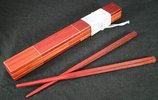 Stickman Chopstick Box (#13, Second Edition) by Robert Yarger Purchased from Cubicdissection. Beautifully made from paduak and bloodwood, with maple inlays. Seven moves are required to release the two chopsticks, which are themselves beautifully inlaid. |
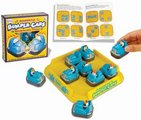 Magnetic Bumper Cars - Popular Playthings / Huntar Co. Inc. 2006 |
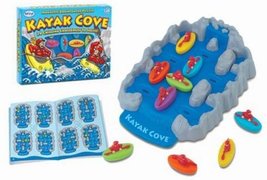
Kayak Cove, from Popular Playthings. |
|||||||||||||||||||||||
 The DigiDisc is a series of tori with mathematical symbols along their peripheries. Arrange them so that all equations are true. I wrote a computer program to solve DigiDisc. |
 The Magnetic Puzzle Ball from Executive Minds contains a central sphere - each piece has a stem ending in a magnet that attaches to the sphere. |
 The magnetic globe is a spherical jigsaw. |
|||||||||||||||||||||||
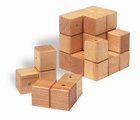 The MagnaCube is like a Soma (though not the same set of pieces), but each piece has a few magnets which constrain the solution. |
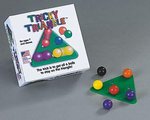 The Tricky Triangle requires you to position some spheres containing magnets so that they will not mutually repel. |

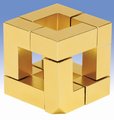 The pieces of the Blue Cube mate a certain way via magnets. Bits and Pieces also offers an aluminum version called "Iso-Crate" by R.D. Rose. |
|||||||||||||||||||||||
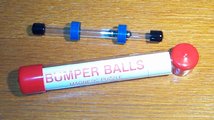 The object of Bumper Balls is to get the 3 balls separated |
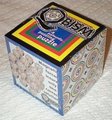 Qbism |

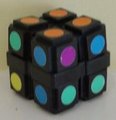 OctaCube - 8 sub-cubes attach to a central frame. Arrange the colors per rules. There is also a black non-magnetic version. |
|||||||||||||||||||||||
|
|||||||||||||||||||||||||
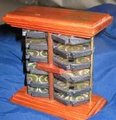
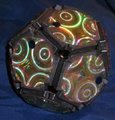
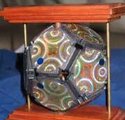
Pentera U.S. Patent 5411262 - Smith 1995 |
MagnaTease Classic Games Co. |


Laker Cubes |
|||||||||||||||||||||||
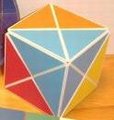
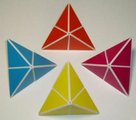
(Mind Madness?) Cube-It 24 pieces - form a cube such that on the surface same colors don't touch (Saw one for sale here.) |
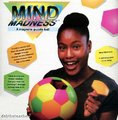
Mind Madness Ball similar to the gray-toned ball above, but larger |
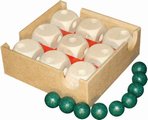
Balance of Power A dexterity puzzle or a game - the blocks have detents at various positions. Arrange the blocks in an attempt to place the magnetic marbles in the detents such that they remain stable. Score higher for using more closely spaced detents. The detent arrangement shown has maximal spacing. |
|||||||||||||||||||||||
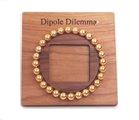
Dipole Dilemma by Chris Morgan Pack the 28 magnetic spheres flat in the rectangle |
 Mattel Force Field |
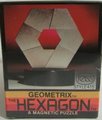 Geometrix The Hexagon - Reiss Style 415 1980 |
|||||||||||||||||||||||
  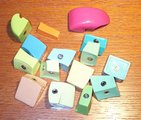 Olizoid See U.S. Design Patent D509263 awarded to Daniel R. Oakley in Sept. 2005. |
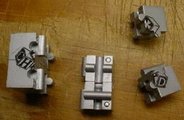 CHKD Cube Eight aluminum pieces with embedded magnets. Not difficult, but a child will be challenged. Based on the logo, this seems to be a promo item for the Children's Hospital of the King's Daughters. |
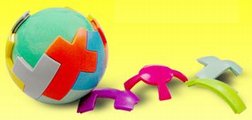
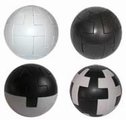 The Magic 16 ball by Idea Ocean, and the Tetrix Ball Twins from Mefferts. |
|||||||||||||||||||||||

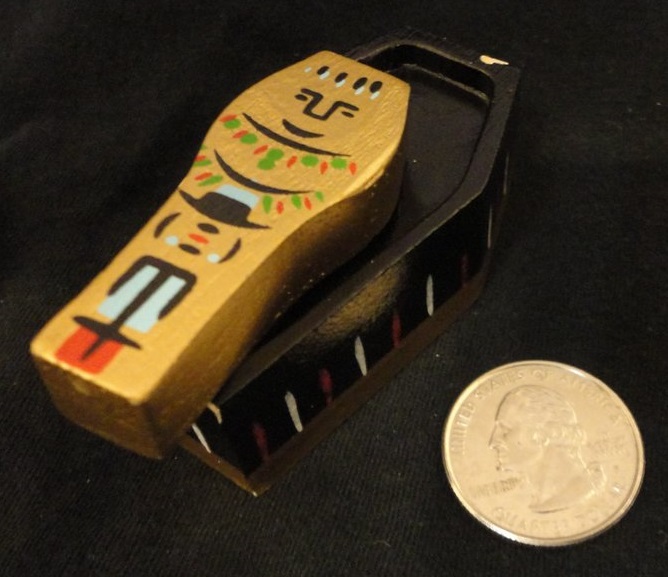
This is the King Tut Magic Mummy Get the Mummy to stay in the Sarcophagus (or hop out) See U.S. Patent 2458970 - Wilson 1949 The first is an original plastic version, the second is a wooden version issued by Bits & Pieces. |
|||||||||||||||||||||||||
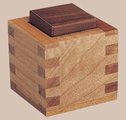
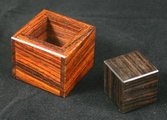
This is the "One Piece Packing Puzzle" designed by Simon Nightingale. The cube and box contain hidden magnets and a mechanism that prevents the cube from seating in the container until it is properly oriented and deliberately inserted. I include this puzzle here rather than in the "Packing" category since the magnets are integral to its operation. The first instance is a copy called "Pack It In" from B&P. The second is a really nice version made by Eric Fuller in 2008. |
|||||||||||||||||||||||||
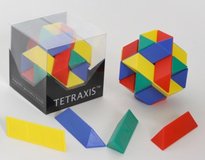
Tetraxis by KO Sticks LLC Produced with support from the Museum of Mathematics |
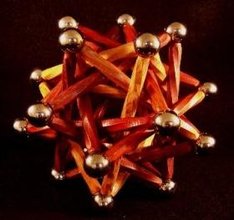
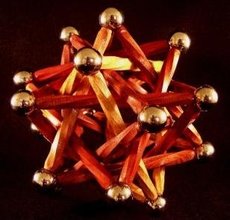
I decided to purchase one of John Devost's HexTwist Five Intersecting Tetrahedrons puzzles - it is a geometric artwork, a real dexterity assembly challenge, and a great example of John's woodturning skills - each rod is lathe-turned to have a special twisting shape. The rods are made from exotic woods, including: Purpleheart, Bloodwood, Redheart, Bubinga, and Lacewood. They are held together by magnetic tips and chrome balls. This puzzle has also been known as the "Poor Man's Merkaba" or PMM. |
||||||||||||||||||||||||
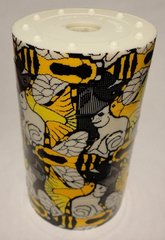
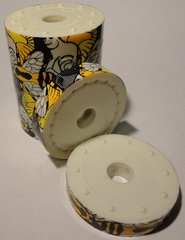
Escher-themed Magnetic Cylinder Puzzle |
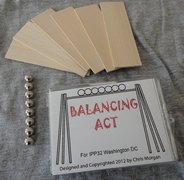 Balancing Act, designed and exchanged at IPP32 by Chris Morgan, made by Chris Morgan and Saul Bobroff |
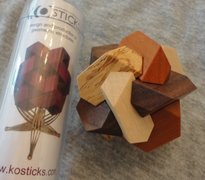 A Kosticks puzzle a gift for IPP32 committee members. Thanks, Chris! |
|||||||||||||||||||||||
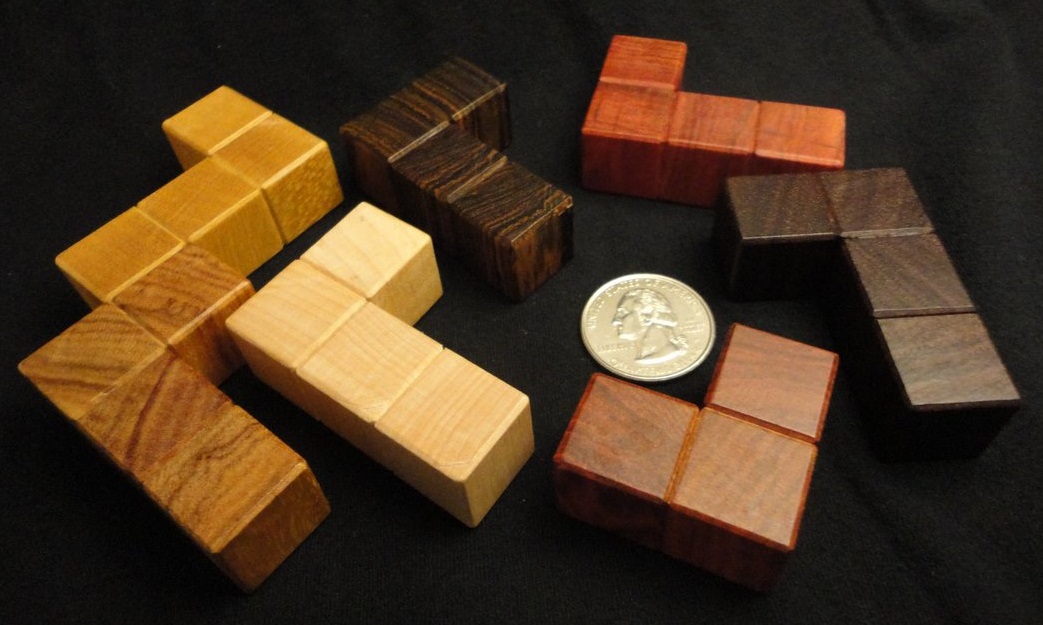
Rules of Attraction - designed by Laszlo Molnar and made by Brian Menold Assemble a stable 3x3x3 cube from the seven pieces, each of which contains hidden magnets which of course frustrate all but the correct juxtapositions of pieces. I had to buy one after hearing Brian's tale of how difficult these were to make in his workshop! |
|||||||||||||||||||||||||
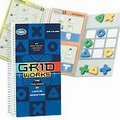
Gridworks - Thinkfun |
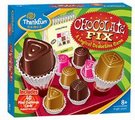
Chocolate Fix - Thinkfun |
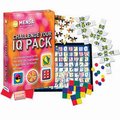
The Mensa "Challenge Your IQ Pack" contains several logic challenges. (Red version) |
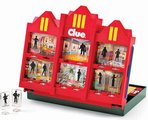

The classic game of logical deduction Clue has been simplified and turned into a solitaire puzzle game called Clue Suspects. Given six rooms, a body, up to 11 suspects, and a challenge card providing a set of clues, deduce who must be in the room with the body, and therefore be the murderer. |
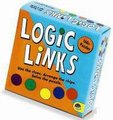
Logic Links By Mindware. Use given clues to deduce where to place colored chips. |
|
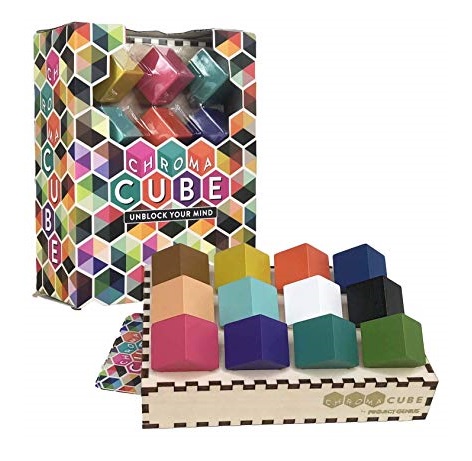
Chroma Cube - issued by Project Genius Arrange the grid of colored blocks according to clues provided on a set of graduated challenge cards. |
||
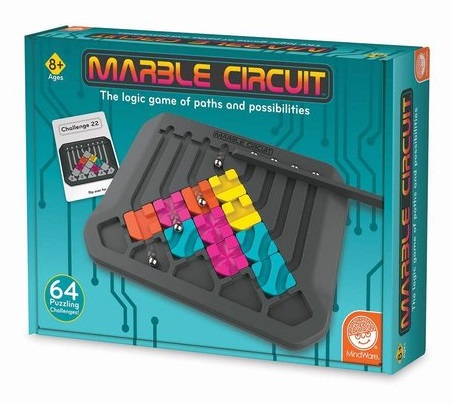
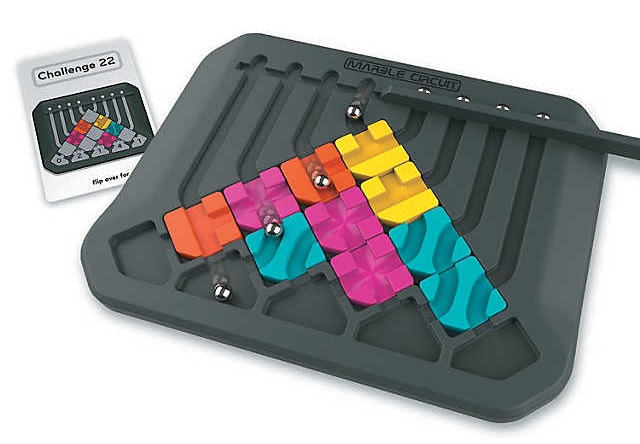
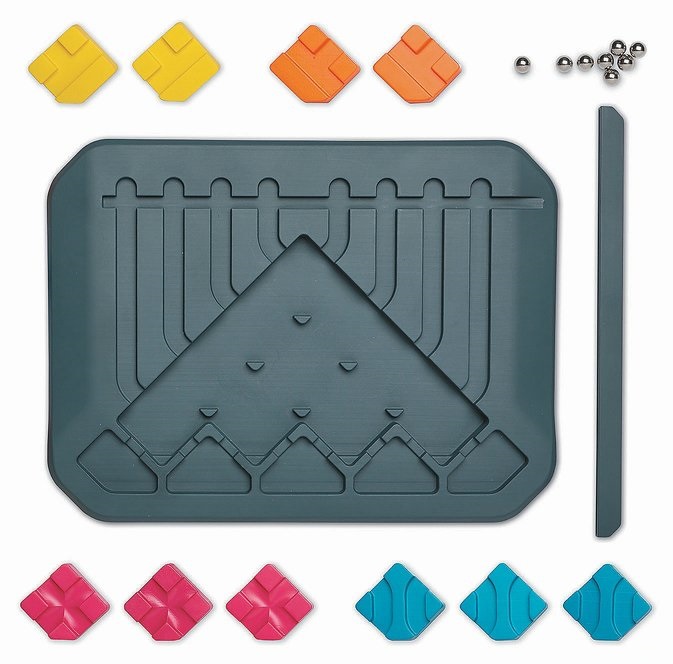
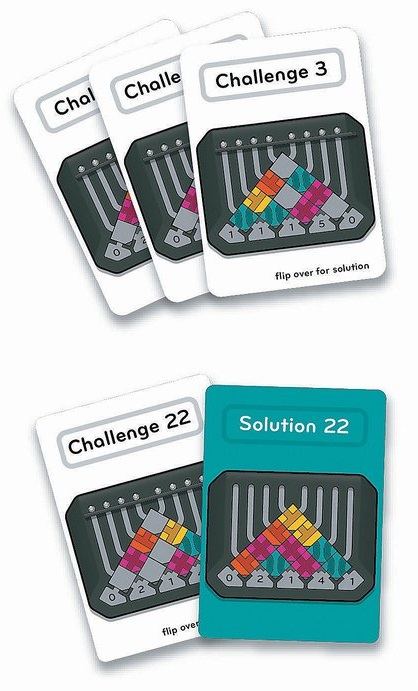
Marble Circuit - by MindWare Invented by Sjaak Griffioen, prototype by Oskar van Deventer, challenges by Wei-Hwa Huang |
||
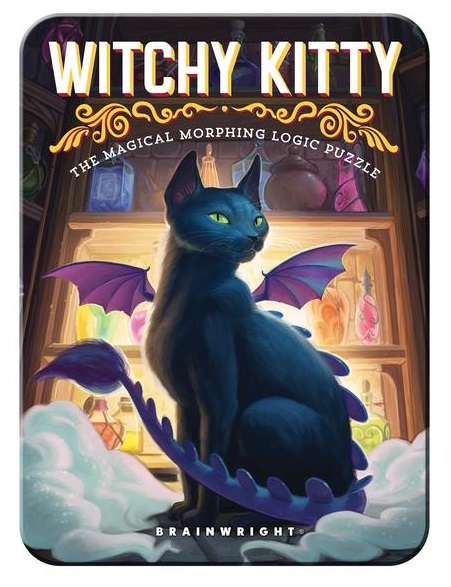
Witchy Kitty - Brainwright Thanks, Alison! |
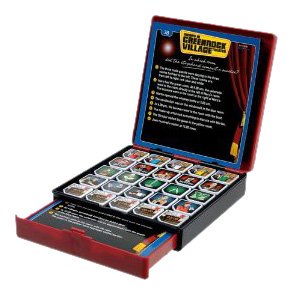
Murder in Greenrock Village Theatre - issued by Koninklijke Jumbo B.V., a Jumbo Diset company. I was able to find an English version on a prime online shopping site. The puzzle comes in a nice little case including 25 tiles - 5 each of victims, locations, weapons, suspects, and times - and 50 scenario cards where you must deduce the proper matchups based on a set of clues. |
|
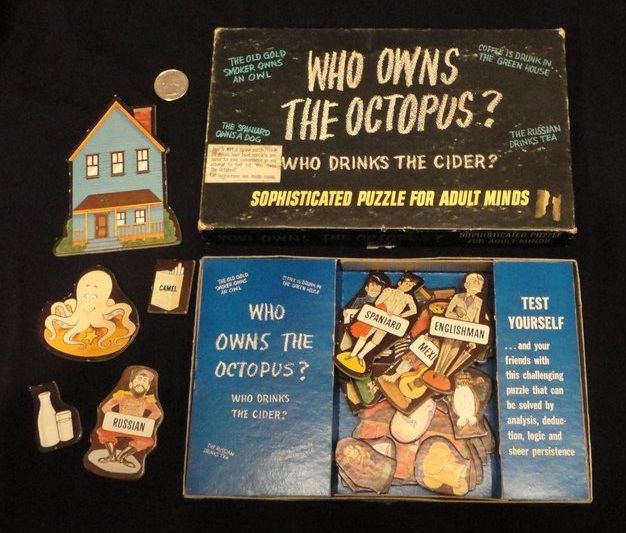
Who Owns the Octopus? - Copyright 1972 by A. Freed Novelty Inc. New York NY
The 25 pieces comprise five each of:
One must determine five groupings of house/person/pet/beverage/cigarette brand based on fourteen clues given inside the box cover, and answer the two questions, "Who owns the octopus?" and "Who drinks the Cider?" Here are the clues, so you can try this vintage puzzle for yourself:
|
||
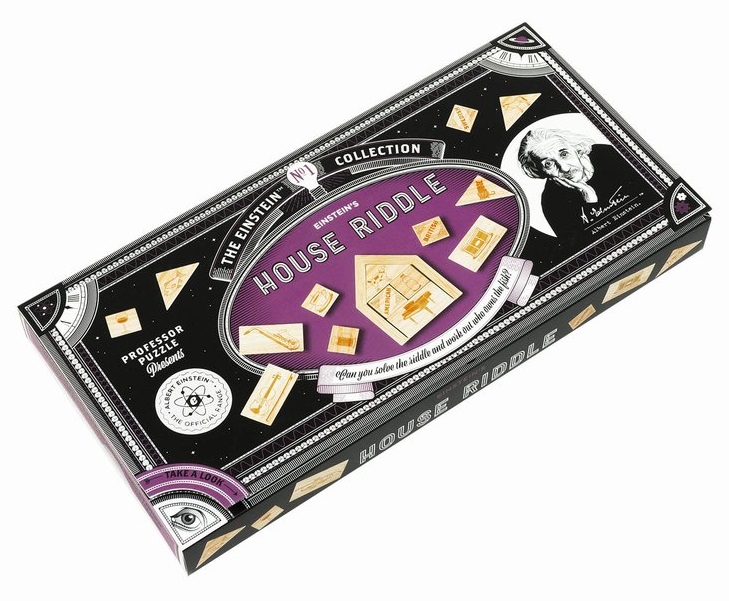
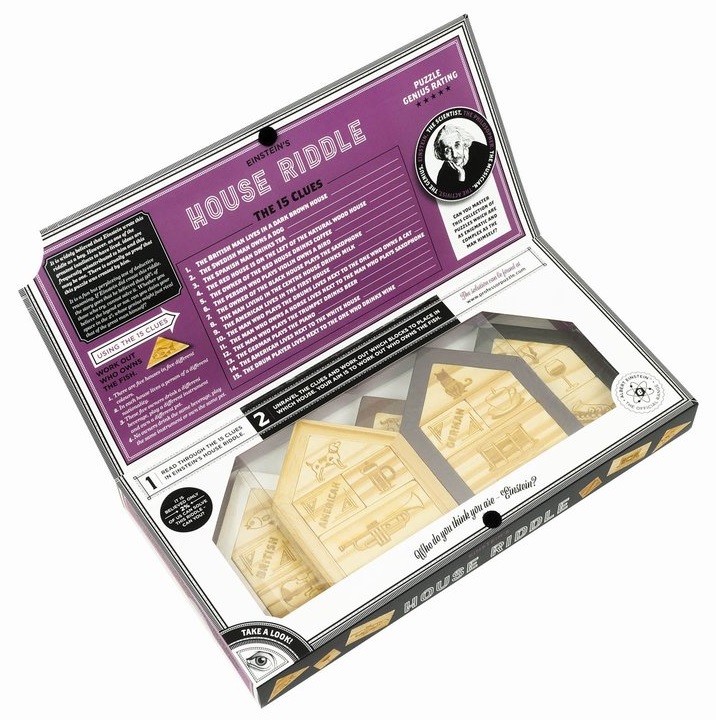
Einstein's House Riddle issued by Professor Puzzle. It is an updated and more politically correct version of the Octopus puzzle, with wooden pieces and only a single scenario to solve. Overall I found it simpler than the Octopus puzzle. |
||
|
|
||||||||||||||||||||||||||||||||||||||||||
Mouseover the box below to see the answer:
| Light both ends of one of the fuses simultaneously, along with one end of the other fuse. When the first fuse (lit at both ends) has burned out, 30 seconds will have elapsed. Immediately light the other end of the second fuse, which will have already been burning for 30 seconds from one end. Its remaining length will now be consumed in 15 additional seconds. When it is gone, 45 seconds will have elapsed from when you first lit the fuses. |
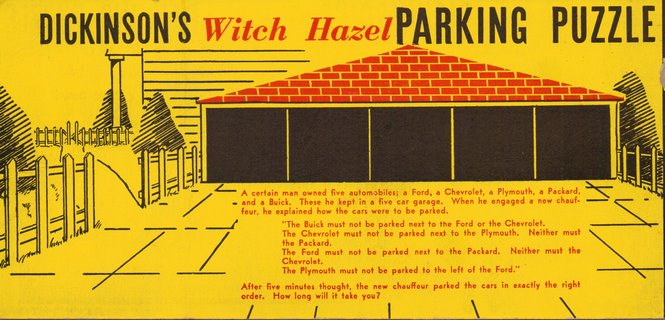
Construct the following chart:
Car on its LEFT on its RIGHT F EFCLAB EFCLAB C EFCLAB EFCLAB L EFCLAB EFCLAB A EFCLAB EFCLAB B EFCLAB EFCLAB |
At the outset, we don't know what is to the left or right of each car.
However, right away we can eliminate from each car's left and right lists that
car itself (unlike people, cars cannot be "beside themselves" :-)
Car on its LEFT on its RIGHT F E.CLAB E.CLAB C EF.LAB EF.LAB L EFC.AB EFC.AB A EFCL.B EFCL.B B EFCLA. EFCLA. |
|
Now consider the first constraint, which gives us two facts
1. B and F cannot be neighbors, and 2. B and C cannot be neighbors. Eliminate the appropriate entries from the chart, replacing them with the numbers 1 and 2: Car on its LEFT on its RIGHT F E.CLA1 E.CLA1 C EF.LA2 EF.LA2 L EFC.AB EFC.AB A EFCL.B EFCL.B B E12LA. E12LA. |
Next, consider the second constraint, which again gives us two facts
3. L and C cannot be neighbors, and 4. L and A cannot be neighbors. Car on its LEFT on its RIGHT F E.CLA1 E.CLA1 C EF.3A2 EF.3A2 L EF3.4B EF3.4B A EFC4.B EFC4.B B E12LA. E12LA. |
|
The third constraint tells us 5. A and F cannot be neighbors 6. A and C cannot be neighbors Car on its LEFT on its RIGHT F E.CL51 E.CL51 C EF.362 EF.362 L EF3.4B EF3.4B A E564.B E564.B B E12LA. E12LA. |
Apply the last constraint, 7 - eliminate L from the LEFT list of F:
Car on its LEFT on its RIGHT F E.C751 E.CL51 C EF.362 EF.362 L EF3.4B EF3.4B A E564.B E564.B B E12LA. E12LA.We'll use this final chart to solve the puzzle... |
A Vanish Puzzle is a cleverly concocted illustration or geometric arrangement, showing a number of objects or a specific area and comprising pieces that, when rearranged, result in a seeming change in the number of objects or size of area depicted.
According to G. Frederickson in Dissections: Plane & Fancy, the first example of vanishing area puzzles was reported in the book Libro d'Architettura Primo by Sebastiano Serlio (1475-1554). (Google books link)
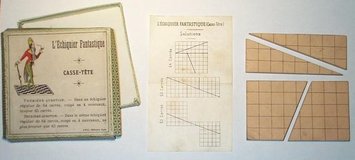 L'Echiquier Fantastique is a French version of the geometric vanish Gardner called
Hooper's Paradox.
L'Echiquier Fantastique is a French version of the geometric vanish Gardner called
Hooper's Paradox.
The area of the figure seems to vary depending on how the pieces are arranged - as a square, the area is 8x8=64, but as a rectangle the area is 5x13=65. The pieces can also be put together so that the apparent area is only 63. The wooden pieces are actually very useful in showing the fallacy involved. |
The Jerry Slocum collection at the Lilly Library contains a few examples of vanish puzzles.
Sam Loyd, the premier American Puzzlist of the 19th century, created a series of vanish puzzles, now classics, including Get Off the Earth. In one position, there are 13 Chinamen. Move the knob to rotate the inner disk, and one vanishes - now there are twelve! Patented and Copyrighted 1896 by Sam Loyd (US563778A). My copy was published as an art supplement to the Philadelphia Inquirer, Sunday July 12th 1898. Gardner informs us that more than 10 million copies were sold during Loyd's lifetime.
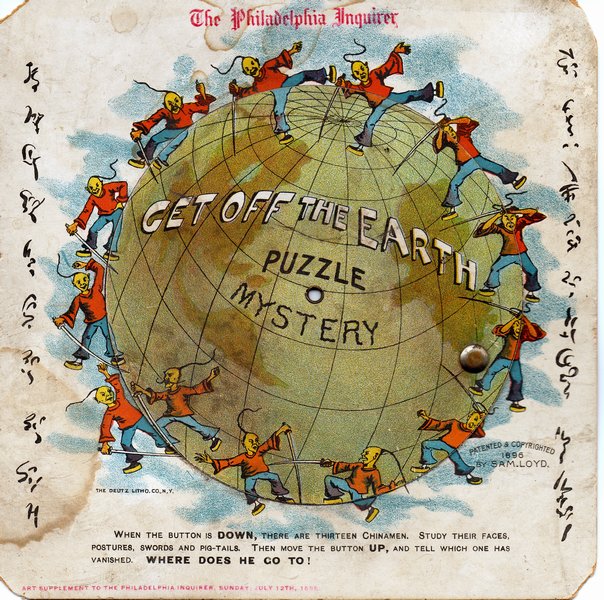 Click the image to make a Chinaman vanish!
Click the image to make a Chinaman vanish!
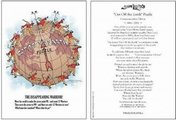

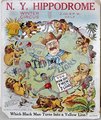
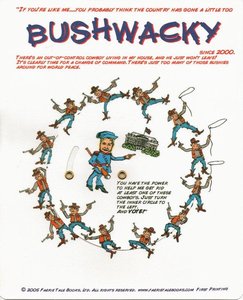
Bushwacky A modern version of Sam Loyd's classic Get Off the Earth vanish puzzle. |
The magician Theodore L. DeLand, Jr. (1873-1931) copyrighted a version of the vanish puzzle in 1907. It was printed in various forms, including "La Mysterieuse" (which I do not have). Gardner calls this the DeLand Paradox.
|
|
|
|
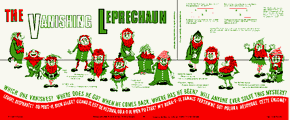
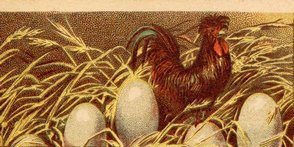 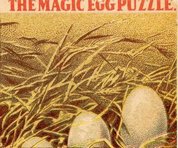
|
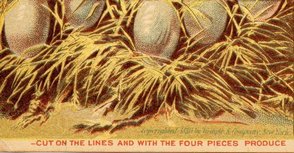 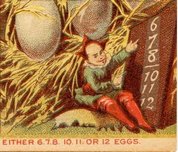
|
Here is a modern variant of the vanish, called Who Turned to Doggie Doo? by Robin Debreuil. You can see it on John Rausch's site here, and at Debreuil's site where you can download a free printable version. (Note: on Debreuil's blog, he put this in the public domain.)
Before:
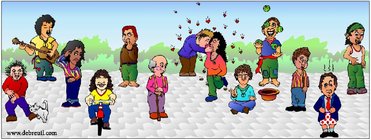
After:
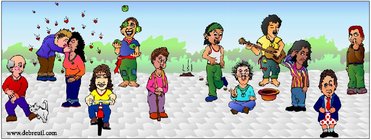
Geometricks is a beautiful small folio of five different and multi-faceted dissection puzzles, copyright 1939 by M. Grumette, and published by Edu-K-Toy Institute, New York. It's in great shape for its age. Each page describing one of the puzzles is an envelope and encloses a card containing the corresponding puzzle pieces. The puzzle pieces are on good stock punch-out cardboard - all of the pieces are present and intact, including the frames. I've tried to show a glimpse of each page/puzzle below.
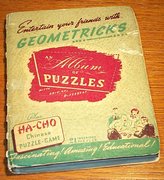
|
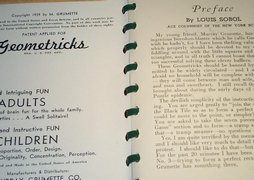 Copyright 1939! |
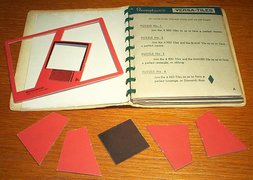 Versa-Tiles
|
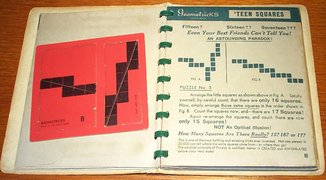 'Teen Squares The four pieces can be arranged to apparently show a total of 15, 16, or 17 black squares. A classic geometric vanish. |
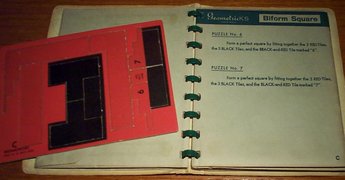 Biform Square
|
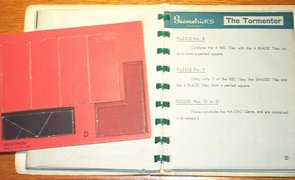 The Tormenter
|
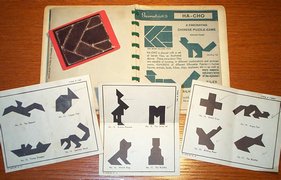 Ha-Cho Form various silhouettes from the seven tiles. |
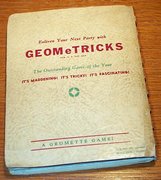 |
Here are some examples of 3-D Geometric Vanish Puzzles, which are related to Packing Puzzles.
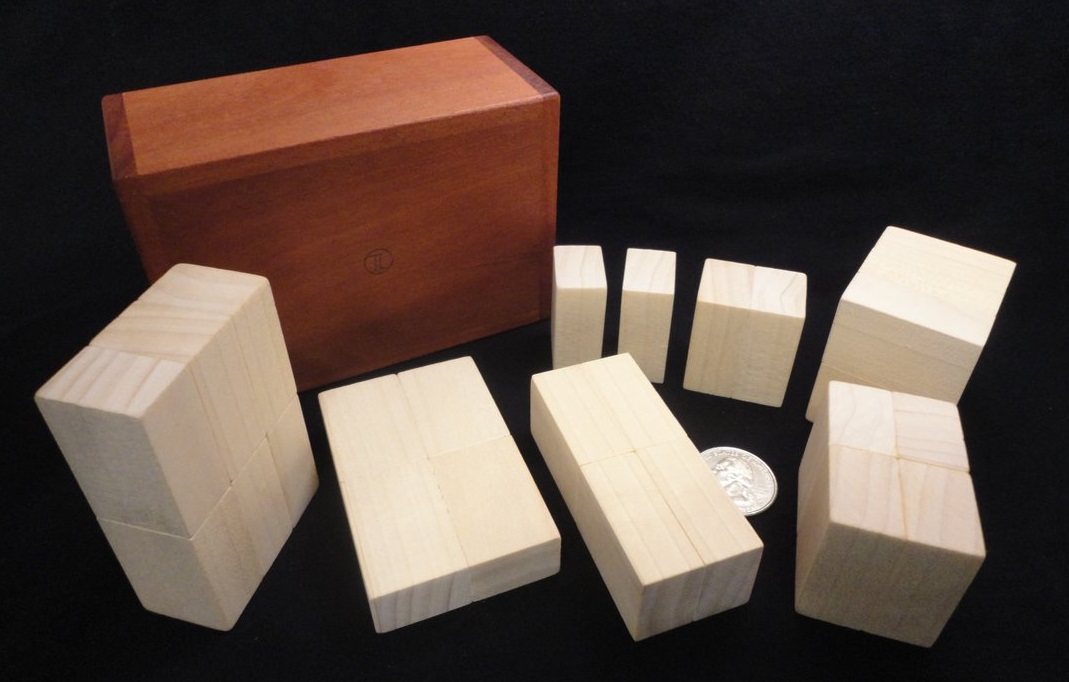
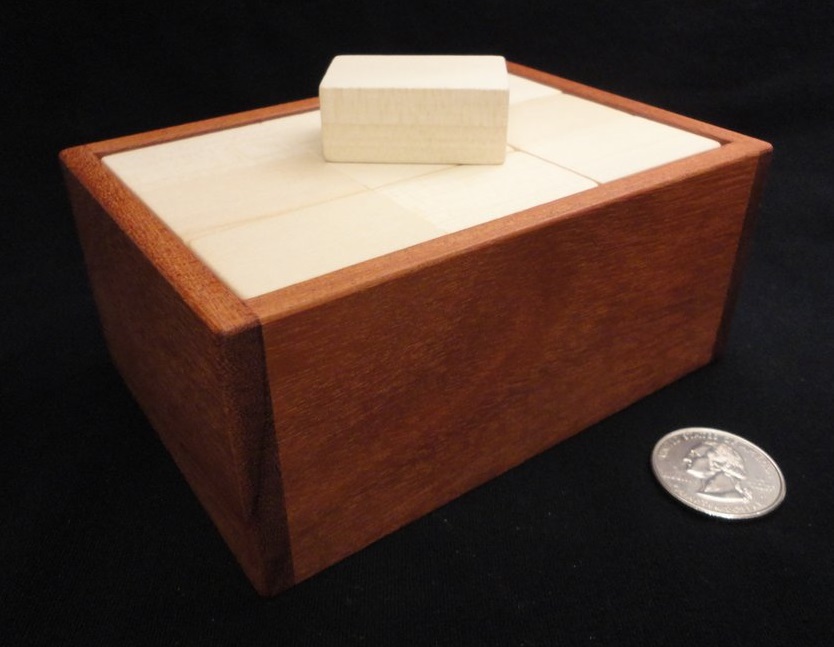
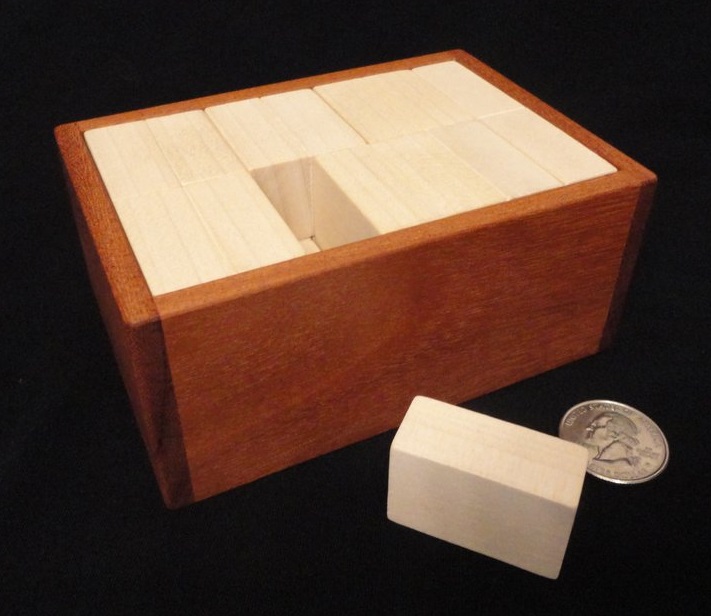
Improved Melting Block (prototype) - John Rausch, made by Tom Lensch Based on an idea by Thomas O'Beirne - the original Melting Block puzzle uses nine pieces (including a duplicate of the smallest) and is described in Creative Puzzles of the World on page 81. John's version uses eight pieces - there are two copies of the smallest block, which measures 35 x 23 x 15mm. The box can apparently be filled either with only one, or both of them. John's improved design has only two solutions each for the 7- and 8-piece fillings.
Note that at the 2016 NYPP, Bill Cutler gave a presentation on
The Trickpack puzzle from HABA is an implementation of the original O'Beirne design.
Another example of this style of "geometric paradox" 3D packing puzzle
|
||
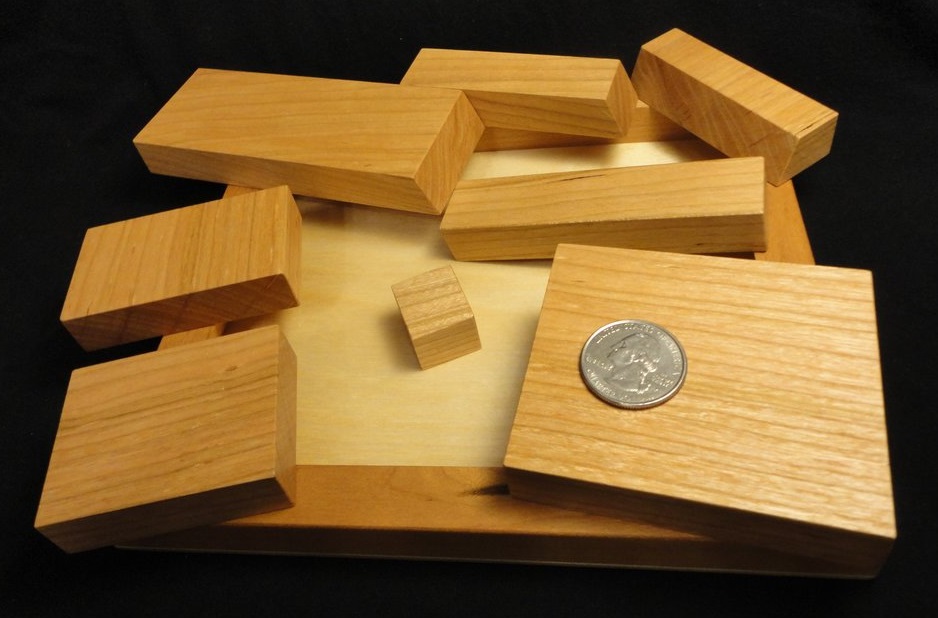
Missing Tile - designed by Goh Pit Khiam and made by Tom Lensch The two shorter edges of the tray have inside bevels, with three of the pieces having matching bevels along one of their edges. First, fit all of the pieces except the smallest block into the tray, filling the opening. Then, re-arrange the tiles to fit in the smallest piece, too. This challenge works differently than the traditional "Melting Block" design, and you'll have to exploit those beveled edges... |
||
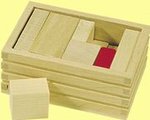 HABA Trickpack See my solution below. |
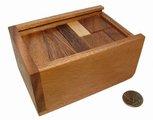 Packing Puzzle A gift from Brett. Eq. to HABA Trick-Pack. |
 3D Geometrex Rex Games Inc. San Francisco, copyright 2000 Sarcone & Waeber Gianni Sarcone described this puzzle in issue 52 June 2000 of the CFF newsletter, where he called it the Paradoxopiped. Start with nine pieces packed in the frame, then add the tenth. Gianni says "more than three solutions can be found." |
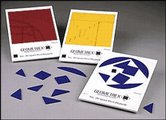 Geometrex Set - Ormazd, Nabucho, and Quirinus In each case the pieces can be rearranged within the tray to fit in an extra square. |
 Think Square - Pressman There are 4 small right triangles, 4 large right triangles, 4 stair-case shaped pieces, and 5 small squares. The pieces can be fit snugly into the tray with and without one of the five small squares. |
|
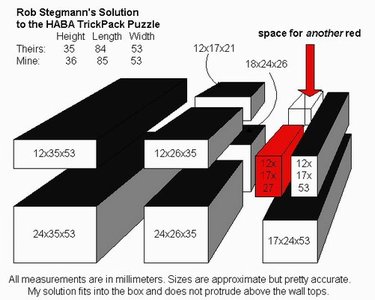
You can find many other examples of vanish puzzles on the web:
Puzzles based on a picture can be printed on paper or card stock. Some are to be cut up and arranged in a particular way. Some call for you to find various figures in the pictures.
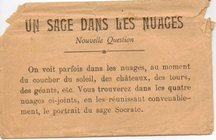
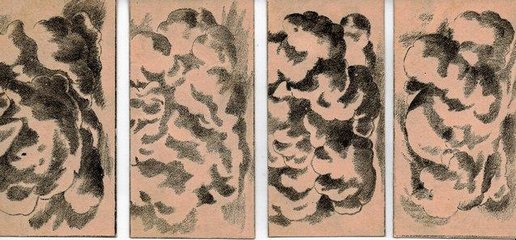
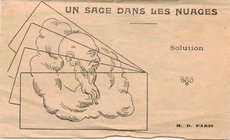
This is a French puzzle called Un Sage Dans Les Nuages - "A Sage in the Clouds." Four rectangular cards depict various cloudscapes. Arrange them so that the face of a wise old sage appears. I don't think the face is very well-formed. Shown in Slocum and Botermans' "New Book of Puzzles" (1992) on page 23. |
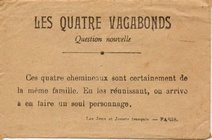
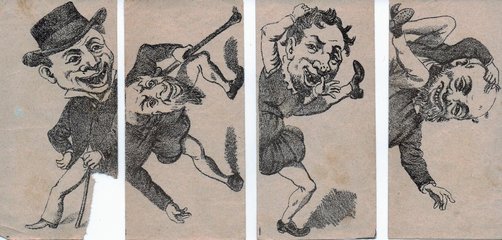
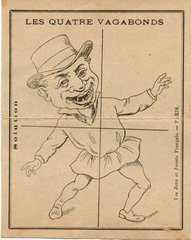
Another French puzzle, called Les Quatre Vagabonds - The Four Vagabonds. Arrange the four cards to form one complete figure. Appears in Hoffmann as Chapter III No. XLI - The Man of Many Parts. Hoffmann says it is of German origin. |
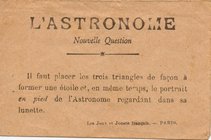
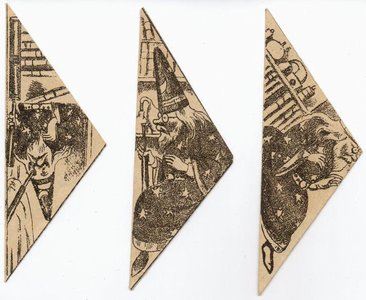
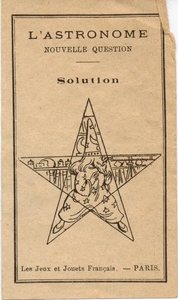
L'Astronome - arrange the three pieces to form a five-pointed star, with an image of the astronomer. |
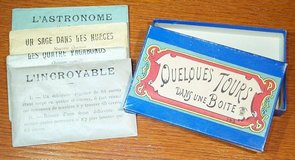
Quelques Tours dans une Boite - In addition to the loose versions of the above puzzles, I obtained this boxed set which includes the four paper puzzles Les Quatre Vagabonds, Un Sage dans les Nuages, L'Astronome, and L'Incroyable (a paper version of the geometric fallacy L'Echiquier Fantastique). You can find an on-line version of this set here, with links to cards you can print and cut out. |
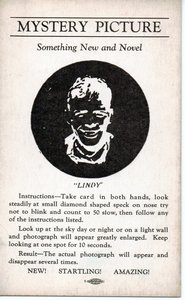 Mystery Picture Something New and Novel "Lindy" Look steadily at small diamond shaped speck on nose try not to blink and count to 50 slow, then look up at the sky day or night or on a light wall and photograph will appear greatly enlarged. Keep looking at one spot for 10 seconds. Result - The actual photograph will appear and disappear several times. New! Startling! Amazing! |
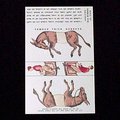
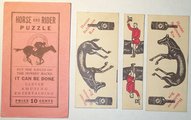
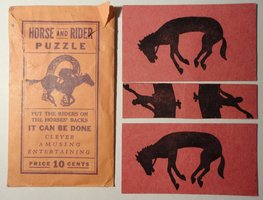
One classic, popularized by Sam Loyd, is seat the riders on (or saddle) the horses (or mules). See U.S. Patent 2082943 - Dutcher 1937. Cut out the three pieces and figure out how to arrange them to depict two complete horses each bearing a rider facing the correct way. This puzzle was used as an advertising premium for Dickinson's Witch Hazel - seat the witches on the cats: 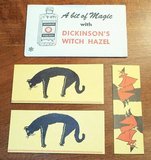
|
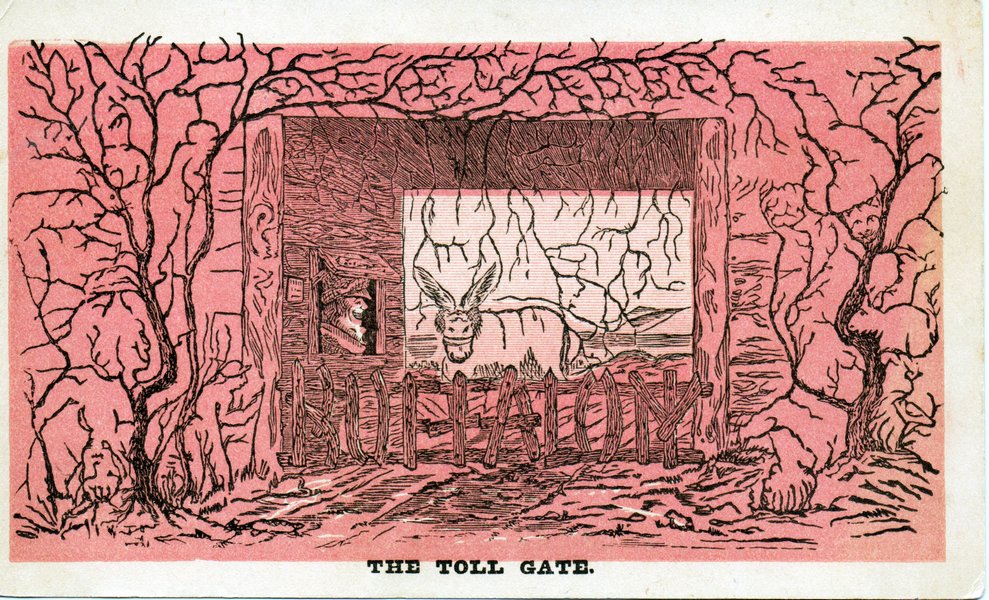
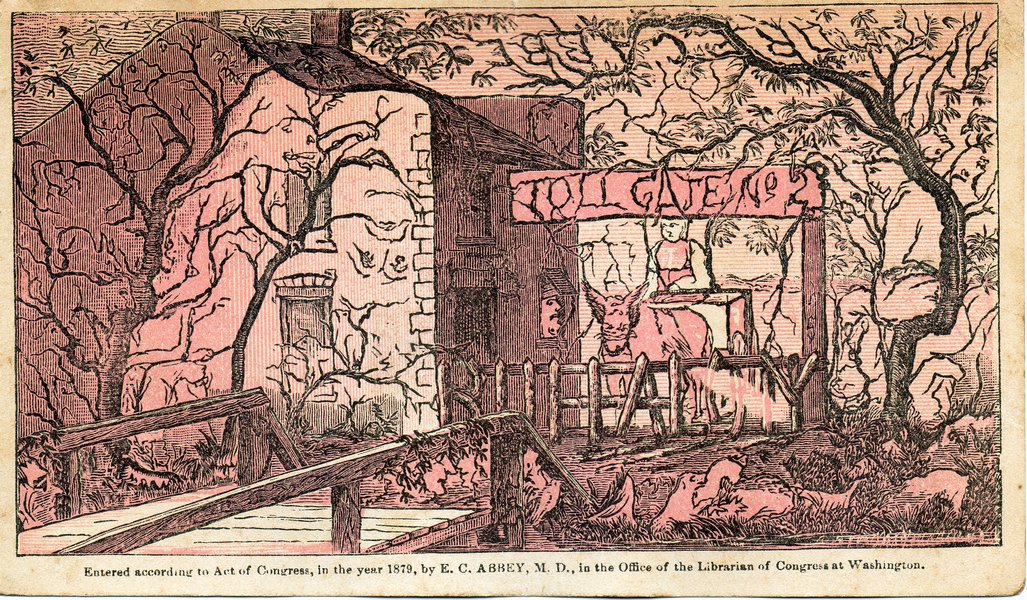
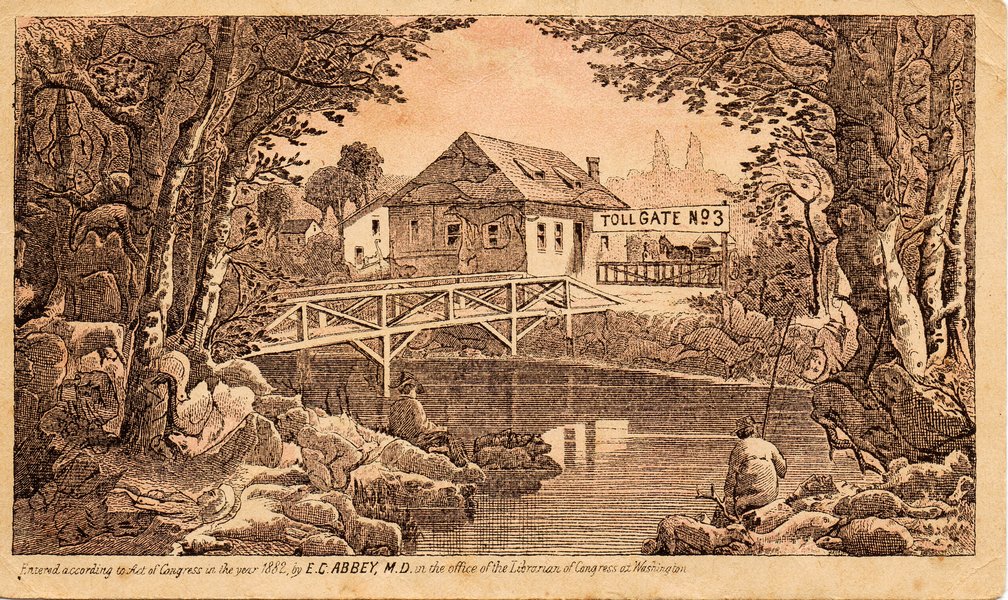
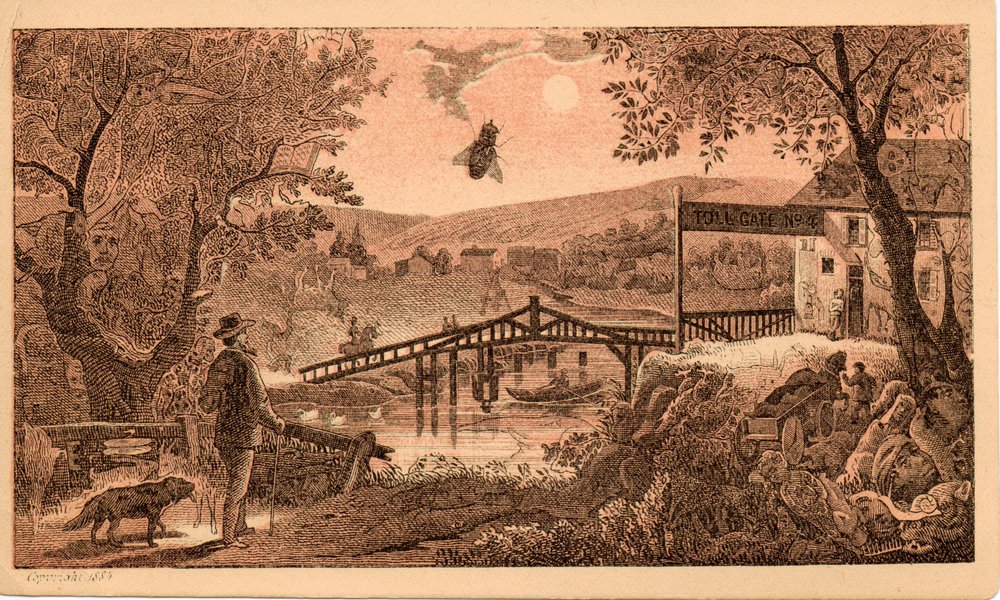
The Truant Boys, a follow-up to the Toll Gate series, by the same Dr. Abbey:
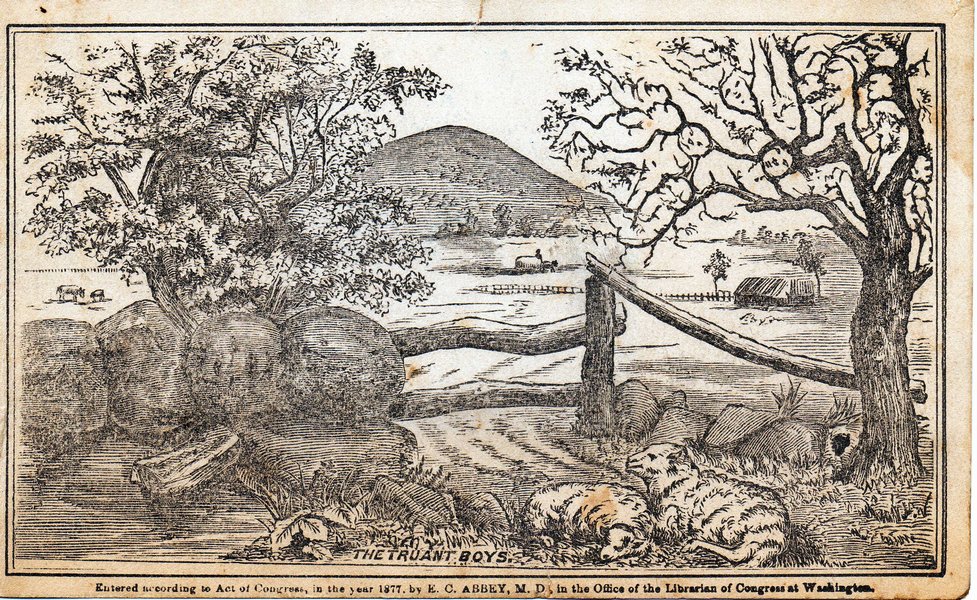
Currier & Ives issued a set of three puzzle-pictures - the Old Swiss Mill, the Puzzled Fox, and the Bewildered Hunter. Thanks to Gianni Sarcone for making me aware of these.
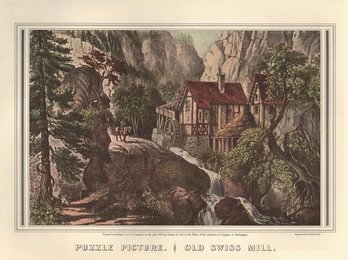
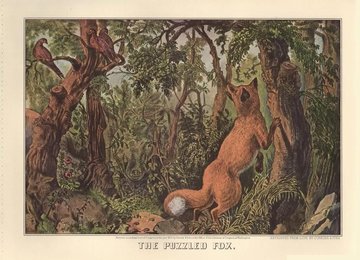
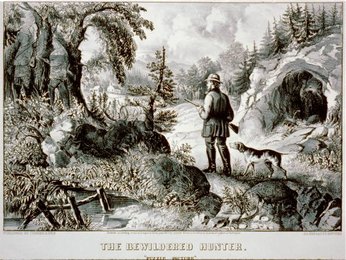
An advertising card for Brown's Bitters:

Why Don't He Sink?
Heat the card to find the answer...
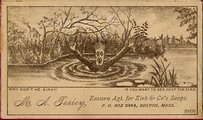
Here are the "cube snakes" - unit cubes linked together so that they pivot in only certain ways, and fold up into a cube shape, usually 3x3x3 but some 4x4x4. In this group are: Another type of folding puzzle is the "plate" puzzle exemplified by Rubik's Magic. A group of independent 2-sided grooved tiles, with embedded picture cards, are connected by a loop of strong fishing line. The stringing pattern is complex, and permits the tiles to be folded around and onto each other in various ways. The objective is to achieve a particular picture pattern and/or shape.
Take a look at Pantazis' site - he has created many original folding plate puzzle designs!
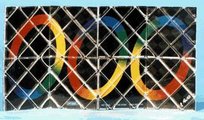
Rubik's Magic - the original 8-tile, black verison. Newer versions are red. Read about Rubik's Magic at Jurgen Koeller's site. |
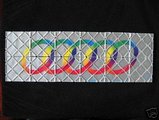
Rubik's Magic Master 12 tiles |

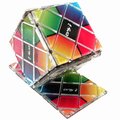
Rubik's Magic Create the Cube |
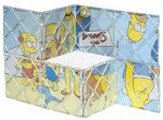
Simpsons novelty Rubik's Magic |
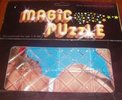
Another novelty version picturing a scantily-clad woman. |
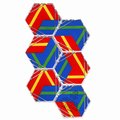
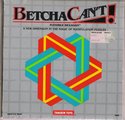
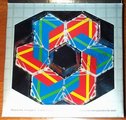

Betcha Can't is a fairly rare version with hexagonal plates. |
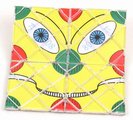
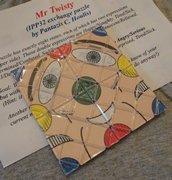
Magic Smile - Purchased at IPP28 in Prague, from Pantazis Houlis also Mr. Twisty, designed, made, and exchanged at IPP32 by Pantazis |
|
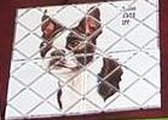
I got this custom 4-tile magic from Juozas Granskas at IPP26. |
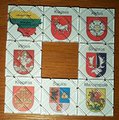
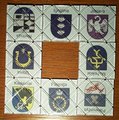
Custom 8-tile Magic - Prague Purchased at IPP28 in Prague, from Juozas Granskas |
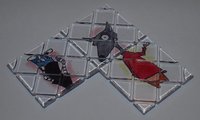
A custom 3-tile Magic, designed by Juozas Granskas. There are three nicely-drawn whimsical characters, each divided across two tile surfaces. The objective is to match the heads to the bodies so that all three characters are whole, simultaneously! I really like this puzzle, and not just because I can solve it. A gift from Jouzas at IPP 29 in SF - thanks! |
|
This is the "Pick the Pickaninnies" postcard puzzle, patented June 4, 1907 ( U.S. Patent 856196 - Lehman 1907 - CCL/273/155) and copyright 1907 by the Ullman Manufacturing Co. of New York.
This puzzle is representative of a time in the history of the United States during which what are today unconscionable racist sentiments were part of everyday life.
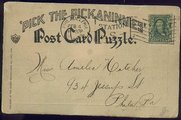
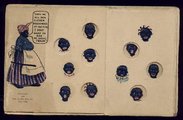
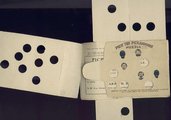
I have a copy sporting a canceled one cent Ben Franklin stamp, postmarked Feb. 4 1908 out of Philadelphia. The puzzle consists of a single card with six flaps that will fold over a central rectangle. One side of the central rectangle is the face of the postcard. On its interior face is an advertisement for Harry H. Kurtz furniture of Philadelphia. One flap depicts a black woman who is saying, "Show me all dem eleben pickaninnies at one time. I don't want to see no white trash." This flap also has eight holes and three black children's faces on it. The other flaps have various patterns of holes and faces of black children and white children. The objective as stated on the card is to "Arrange the flaps, by placing one over another, in such a manner as to show only the eleven pickaninnies."
This style of puzzle has appeared in less offensive versions, for instance the face of Danny Kaye was used to advertise his film "The Inspector General" and a can of peas. In that version only seven faces must appear. Below is a version I made for you to cut out and try. Make windows wherever it says "cut out" and remember to separate the side flaps.

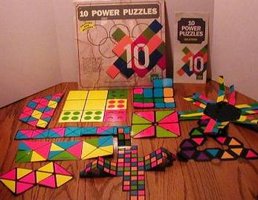
Power Puzzles is a set of ten colorful folding puzzles made of heavy plasticized stock. The designs are copyright by the Ivan-Concept Corporation (Ivan Moscovich), and the set was distributed by Discovery Toys Inc. Each puzzle is to be folded to achieve some specific pattern. |
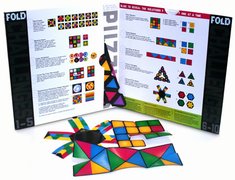
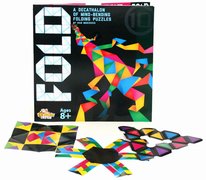
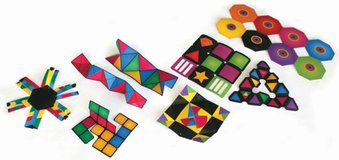
This is Fold A Decathlon of Mindbending Folding Puzzles, by Ivan Moscovich, issued by the Fatbrain Toy Co. It is a re-issue of the Power Puzzles set put out by Discovery Toys. |
Fold the sheet to find the fifth pig...
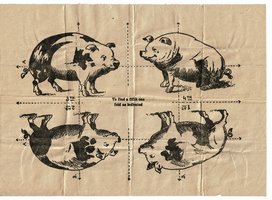
Proper folding of the sheet produces a drawing of Hitler.
This style of puzzle has been used more recently to challenge you to "Find the Fifth Dinosaur" - Saddam Hussein.
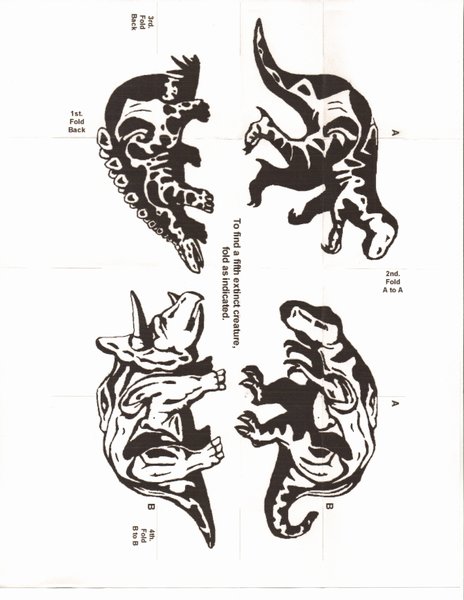
Fold a camel. The star-shaped sheet is printed on both sides and has a slit to the center cut along one radius. See U.S. Patent 2327876 - Edborg 1943.
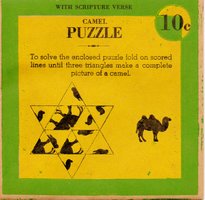
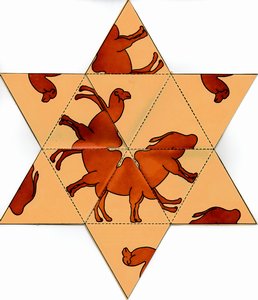
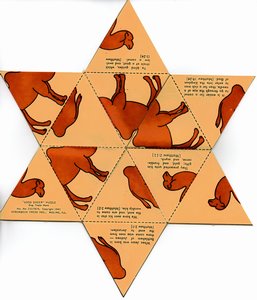
In this puzzle, you fold one way for a cow, another for a horse: U.S. Patent 2327875 - Edborg 1943.
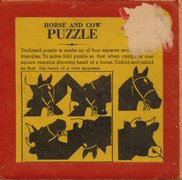
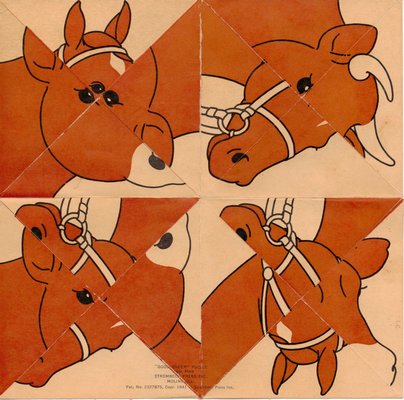
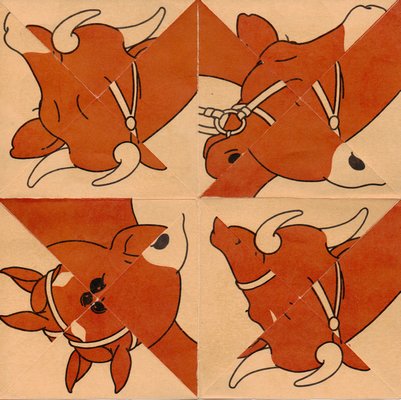
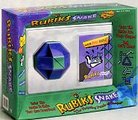 Rubik's Snake is not so much a puzzle as a plaything. Twist it into different shapes. |
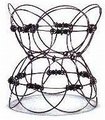 Here is a folding metal "puzzle" (more of a toy) known as "Heaven's Orb." This design actually dates back at least to the Smith patent # 2031231 of Feb. 1936. |

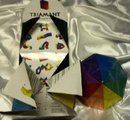
Triamant also sold as "Crazee Diamond" |
 Can-Do Linked blocks in the shape of a can. See U.S. Patent 6637138 - Prost 2003 |
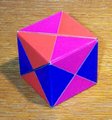
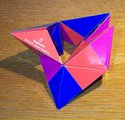 Yoshi's Cube A flexible array of shapes connected by tough plastic sheets. Can be folded into a cube and other shapes. |
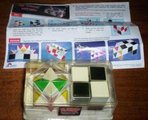 Shinsei Twin Comets or Shinsei Mystery Two units - either can be folded to make the first stellation of the rhombic dodecahedron, or a cube. Each shape is hollow - the stellation will fit inside the cube. This is a copy of a version called the Yoshimoto Cube that was first issued in Silver and Gold colors. Invented by Naoki Yoshimoto in 1971. |
||
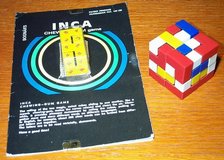
Inca - small and large |
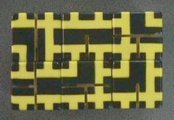
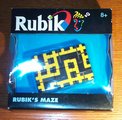 Rubik's Maze |
||
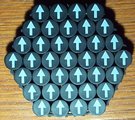
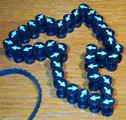

This is Hex, issued back when Thinkfun was Binary Arts. Fold the chain loop into a hexagon so that all arrows face the same direction. A gift from Tom Jolly - I had an instruction sheet but no puzzle - thanks, Tom! I've seen other versions of this on Iwase's site. |
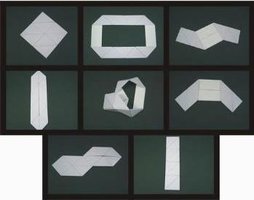
A plastic folding-plate "puzzle" - make different shapes. |
||
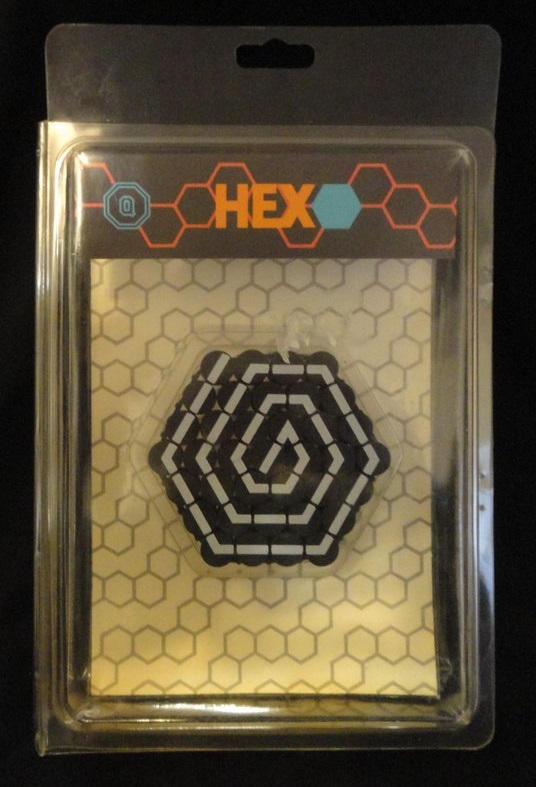
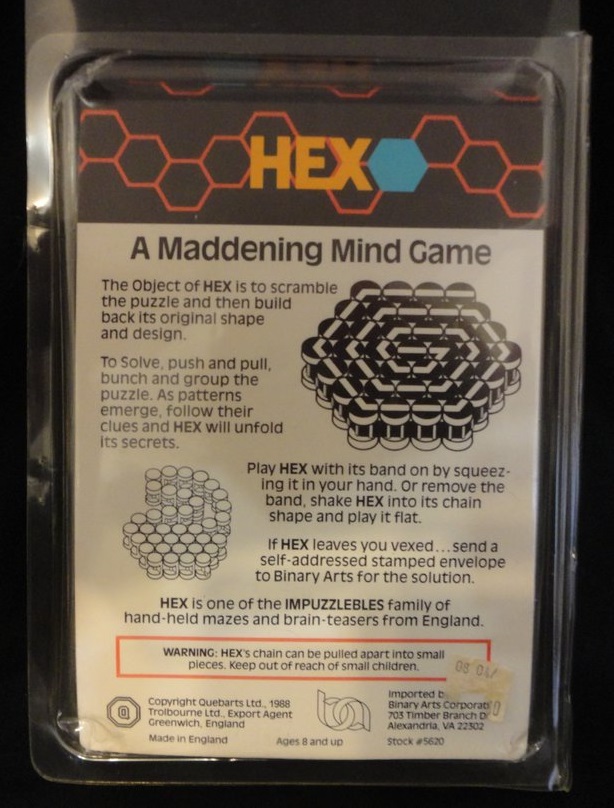
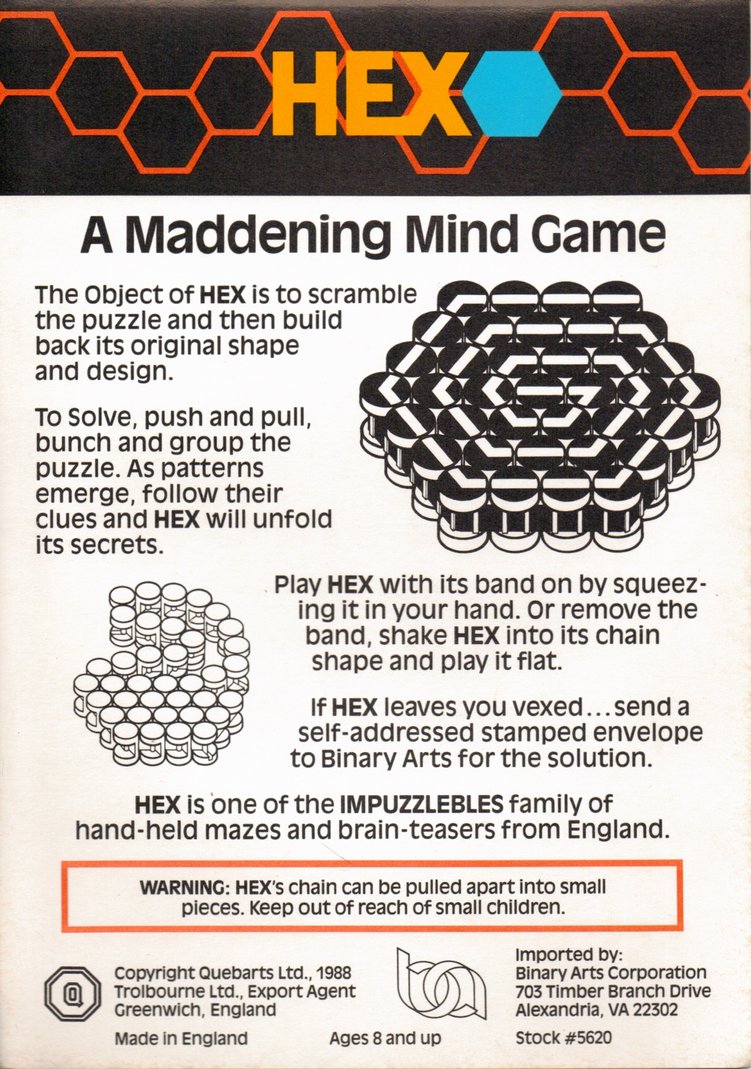
I found another instance of Hex - a vintage puzzle from Binary Arts - in its original package. |
|||
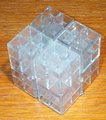
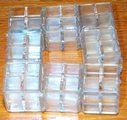
 Happy Cubes by Adult Games. |
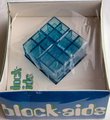
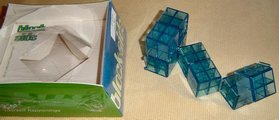 Block-Aids Identical to Happy Cubes by Adult Games - just blue. |
||
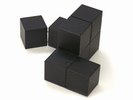 Snoop Cube Fold the eight linked blocks into various shapes, culminating in a cube. Purchased from Torito. |
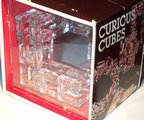 Mag-Nif Curious Cubes 1982 |
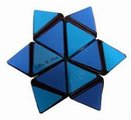
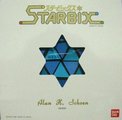
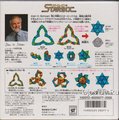
The Starbix folding puzzle/toy, by Alan H. Schoen and issued by Bandai 1987. |
|
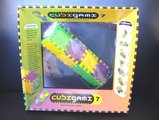 Cubigami 7 from George Miller. Designed by George Miller and Donald Knuth. This is one of the few puzzles that stays on my desk - I find myself frequently picking it up and playing with it. A clever arrangement of hinged squares in a flat sheet, can be folded into each of the 3D tetra-cube shapes except for the 1x2x2 block. |
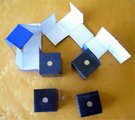 Blue Cubigami from George Miller. This version has four magnetic blocks and a plastic wrapping with embedded metal plates. Arrange the four blocks into one of the tetracube shapes then find a way to wrap them. This version allows the 1x2x2 shape to be wrapped since leaves of the wrapping can overlap. A gift from George - thanks! |
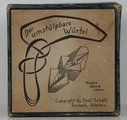
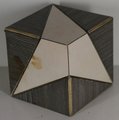
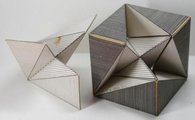
Der Umstulpbare Wurfel (the Invertible Cube) by Paul Schatz of Switzerland. |
|

This is called "Block Chain" but it is a copy of QRIN X by Takeyuki Endo |
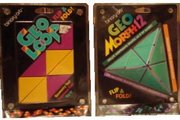
Two vintage folding puzzles from Binary Arts: GeoLoop and GeoMorph12 |
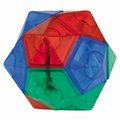
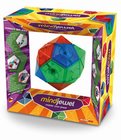
Mind Jewel, designed by Alexander Polonsky - from RecentToys |
|
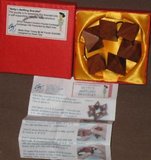
Betty's Baffling Bracelet - designed by Stuart Gee Made by Brian Young Exchanged at IPP27 by Marti Reis Six octahedral pieces strung on an elastic band - fold them to create a self-supporting rhombic dodecahedron. |
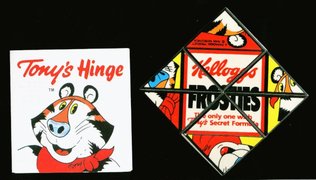
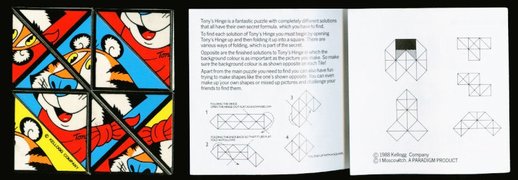
Tony's Hinge |
||
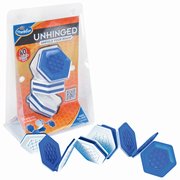
Unhinged by Thinkfun |
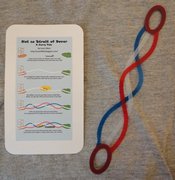 The Not So Strait of Dover by Scott Elliott Kind of folding, kind of tangling - braid the strands using a classic "trick." |
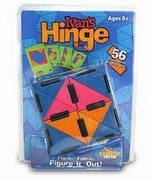
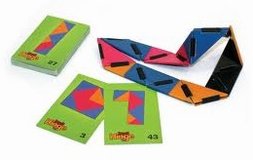
This is Ivan's Hinge, another design by Ivan Moscovich, also issued by the Fatbrain Toy Co. |
|
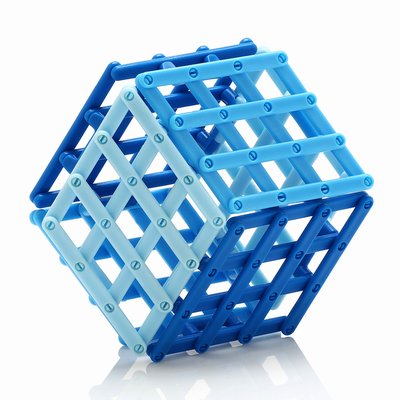
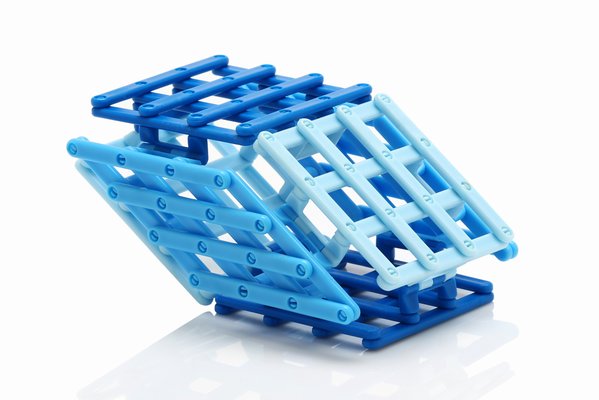
Hopson Kinetic Prismatoy |
Brainwright has issued several intriguing new puzzles.
I picked up the FlexiCube, designed by George Miller. 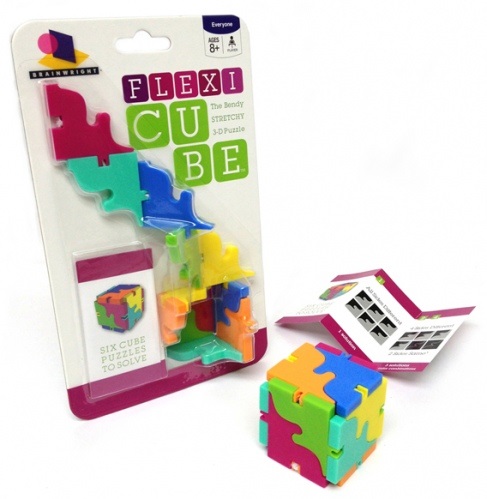
|
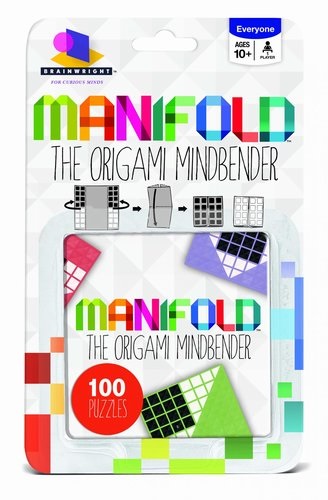
Manifold - issued by Brainwright A pad of 9cm2 sheets, printed with various patterns of light and dark areas. Fold every sheet so one side is all light and the other all dark. Gets quite tricky! Manifold was developed by Jérôme Morin-Drouin at The Incredible Company. You can download a PDF with five sample challenges at their website. |
|
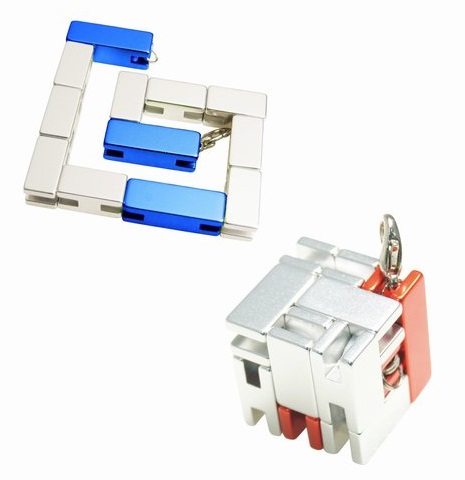
Mini Line Cube - from Metal Art A metal folding puzzle - make a cube. I got a blue and a red. Identical other than color. |
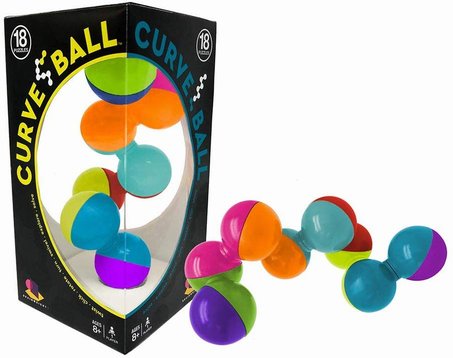
Curve Ball - designed by Eric Harshbarger - issued by Brainwright. Curve Ball is a simple puzzle/toy - the hemispheres of the nodes can be rotated to constrained positions and one must make given shapes from the chain, including a 2x2x2 cubic arrangement. Thanks, Alison! |
||
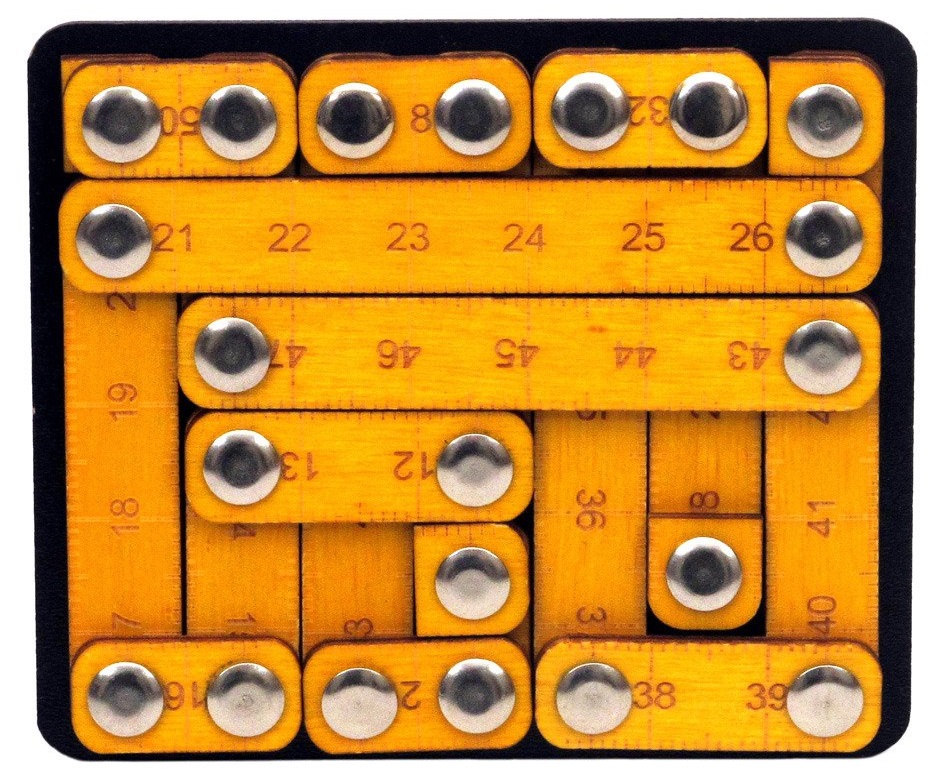
Tough Measures - Constantin - Recent Toys |
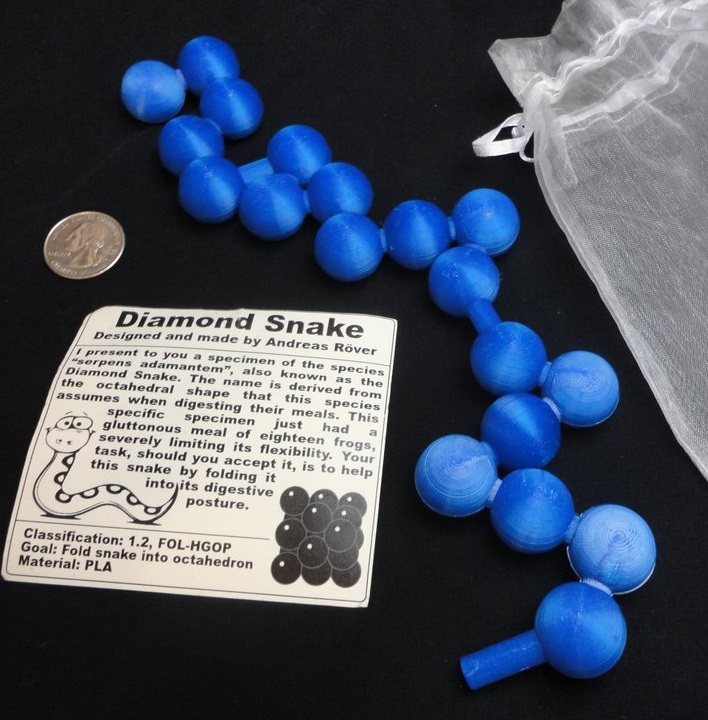
Diamond Snake - designed and exchanged at IPP38 by Andreas Röver A novel take on the traditional "cube snake" puzzle, using linked spheres and with an octahedral target shape. |
||
Here one has to make a careful distinction between games and puzzles. I believe all of these qualify as puzzles...
 My first and still my favorite electronic puzzle was a gift from Darcy, the XL-25.
In principle it is very close to the later Lights Out - but IMHO it has the best sound effect
and the best coordination of that sound effect with the push of the buttons.
My first and still my favorite electronic puzzle was a gift from Darcy, the XL-25.
In principle it is very close to the later Lights Out - but IMHO it has the best sound effect
and the best coordination of that sound effect with the push of the buttons.
|

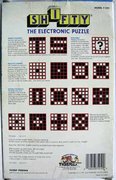
Shifty - Tiger 1989 (Read more at the Handheld Games Museum.) |



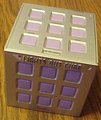 Tiger has marketed several versions of Lights Out. You can also get a version for your Palm PDA. |
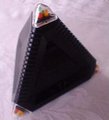 Luminations rather than button pushes it requires tilting |
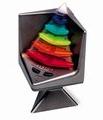 Nemesis Factor |

Orbix |
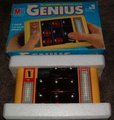
Genius Milton Bradley 1980 |

Merlin Milton Bradley |
 Lite 3 - Tiger |
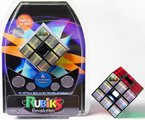 Rubik's Revolution |
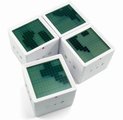
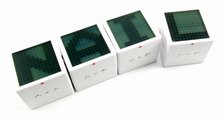
The Cubed Electronic Puzzle, from ThinkGeek. |
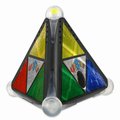 Upside |
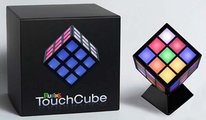
The Rubik's Touch Cube (debuted at $150, purchased for $50 at Best Buy. I think it eventually fell to $19.99!) |
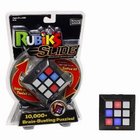
Rubik's Slide See a short video review of the Rubik's Slide. |

Cool Circuits |
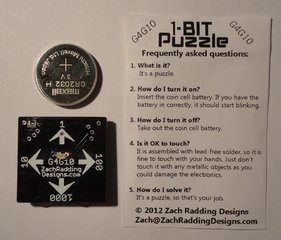
1-Bit Puzzle by Zach Radding An enigmatic 1" square circuit board with a red LED in the center and a membrane button on each of the four top edges - marked 1, 10, 100, 1000. Insert the coin cell battery and the LED starts blinking. What does it all mean? Voted one of the best puzzle finds of 2012. Thanks, Zach! |
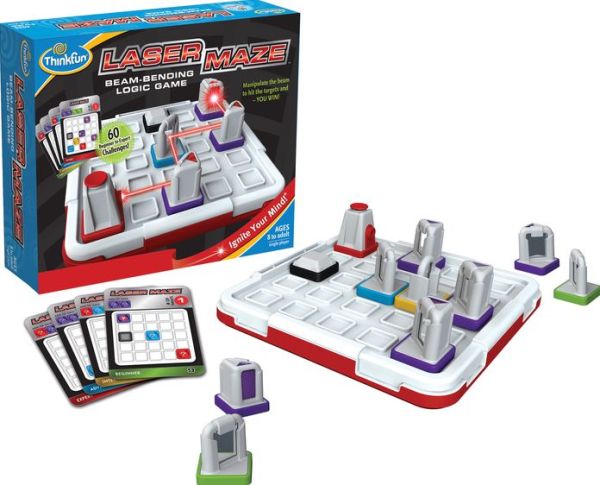 Laser Maze - produced by Thinkfun and
Laser Maze - produced by Thinkfun and
designed with the help of Luke Hooper (the inventor of the laser chess game Khet). |
|
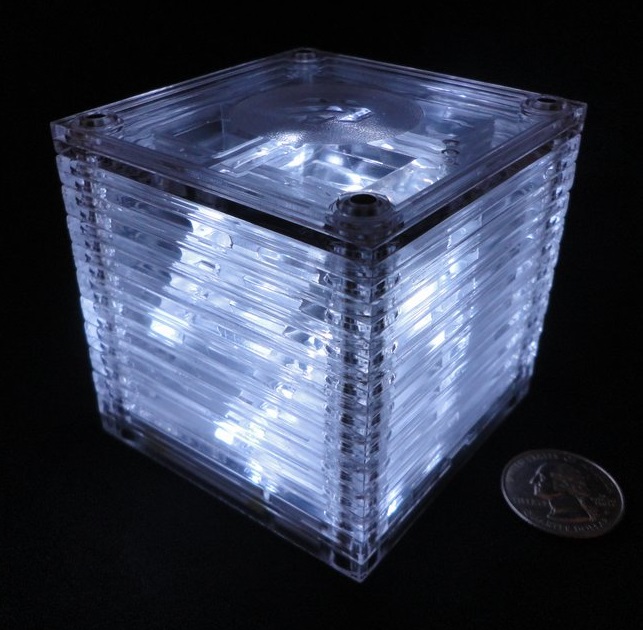
Lightbox3 - designed by Eric Clough Lightbox3 Kickstarter campaign (over) |
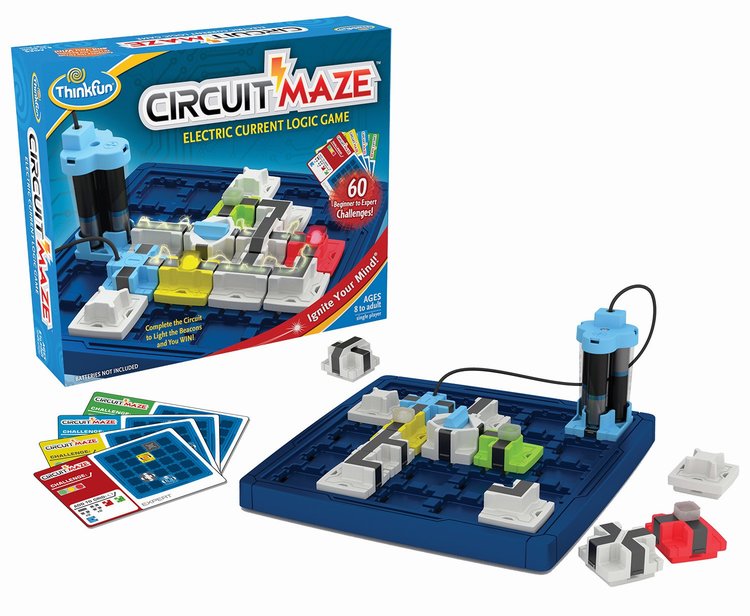
Circuit Maze - produced by Thinkfun created by David Yakos, with Wei-Hwa Huang and Tyler Somer. |
|
|
This is a classic - the Chinese Finger Trap. Insert an index finger into each end, then try to extract them! The woven tube grips more the harder one pulls. |

This is known as a Rattleback or a Celt. Due to its peculiar cross-section, no matter whether it is initially spun clockwise or counterclockwise it always ends up spinning in one direction. |
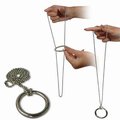
This "Magic Ring" trick consists of a fairly long loop of chain and a metal ring. Hold the chain in one hand and pass the chain through the ring. Now drop the ring, and if you know the technique, the ring will "magically" knot itself onto the chain! |
|
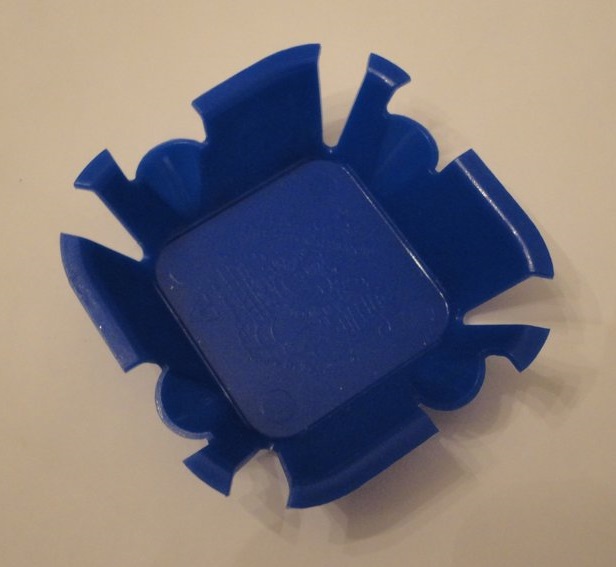
Whatsit - a "guess what this is" object given to me by R. Hess. Thanks, Dick! (I cheated and simply visited the website embossed on the object :-) |
|||
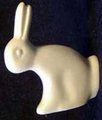
From James Dalgety - the Rabbiduck. Is this a Rabbit or a Duck? Don't answer until you click on the image... The Rabbit/Duck ambiguous image was published by Joseph Jastrow in 1899 in Popular Science Monthly - he discovered it in an 1892 Harper's Weekly, which had reprinted it from the German magazine Die Fliegende Blatter. You can read an article on the Jastrow Illusion, Joseph Jastrow and His Duck -- Or Is It a Rabbit?, by John F. Kihlstrom, online. |
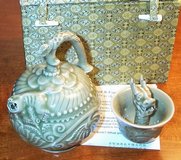
Bottom-filling Teapot and Fairness Cup set Purchased at the 2011 New York Puzzle Party hosted by Tom Cutrofello, in Manhattan at the Museum of Chinese in America (MOCA). MOCA was housing the exhibition "Chinese Puzzles: Games for the Hands and Mind" curated by Wei Zhang and Peter Rasmussen. These are examples of Puzzle Vessels. In the case of the teapot, it is filled through a hole in the middle of the bottom, yet when it is righted it does not leak, and pours tea upright as normally. The Fairness Cup, also known as a Greedy Cup, or Cup of Pythagoras, can be filled and used as normal, but if it is overfilled past a certain level, all the liquid will drain out through a hole in the bottom. The puzzle is, how do they work? |
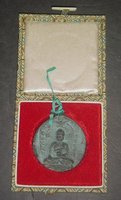
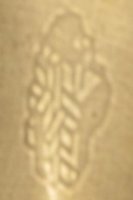
This a modern example of a Chinese Magic Mirror. When sunlight reflects off of its polished brass face (opposite to that shown) properly, one can see an image of the IPP Burr puzzle logo. The unique production technique was invented some 2000 years ago in China and entails more than ten complicated procedures. The reflective surface has extremely subtle warps. The second photo captures the image projected by my copy. |
|
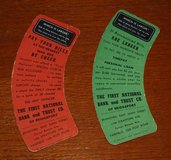
Vintage promotional puzzle Which is Larger? |
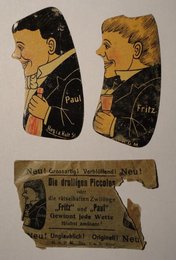
Fritz and Paul A version of the "Which is Larger" optical puzzle made in Germany "New! Great! Amazing! The droll Piccolos or the enigmatic twins Wins every bet very amusing!" D.R.G.M. Reg. i. a. K. - Staat Franz Wieland, Berlin S. 59, Camphausenstr. 25. |
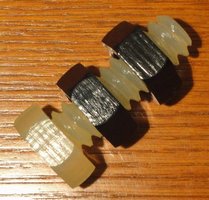
A while back I received from Scott Elliott (Thanks, Scott!), a copy of his Screwy Screw - an "impossible object" type puzzle where the objective is to figure out "how did he do that?" In this case, the two nuts spin on or off the bolt in opposite directions! I.e., one spins clockwise to go on and the other spins counterclockwise to go on. Scott discusses this puzzle on his blog, here, here, here, and here. |
|
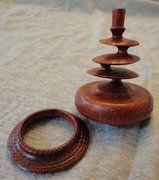 A beautiful hand-turned Offset-Spinning-Top, made by Stephen Chin The puzzle is, how was this lathed? And, when it spins, it displays the intriguing effect of appearing to have independent disks hovering in air. Thanks, Chinny! |
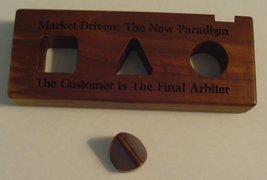
Promotional puzzle from IBM What solid shape will fit through each hole, completely filling the outline? Appears in Wyatt's 1928 "Puzzles in Wood" as "The Wedge Plug Puzzle." Also issued by Journet as "The Geometrical Puzzle." |
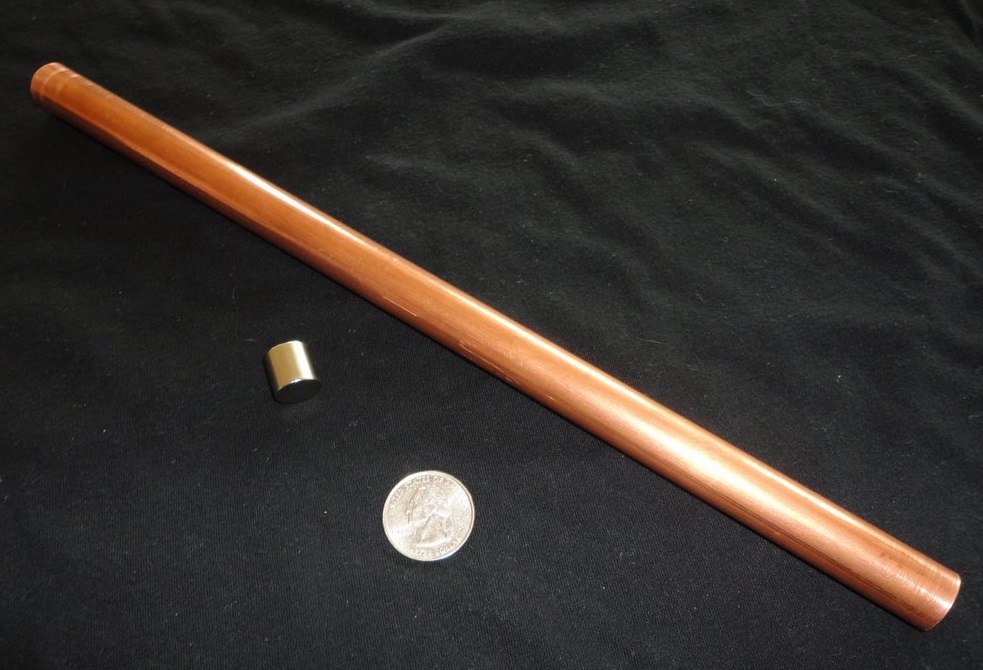
Lenz's Law Demonstration
A moving magnetic field induces an electric current in a nearby conductor - this is called an eddy current. In turn, the induced current will create its own magnetic field that opposes the original magnetic field that created it.
One can demonstrate this using a simple copper tube and a strong magnet that will drop through the tube. The copper tube conducts but is non-magnetic. The magnet will drop through the tube, but much more slowly than a non-magnetic equivalent mass. It's not "sticking" to the tube - rather, Lenz's Law - the opposing magnetic fields - slows it down.
A gift from Brett - thanks! |
|
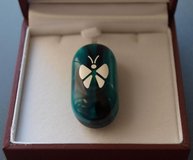
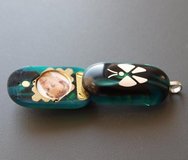
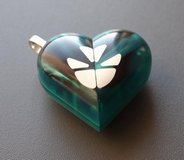
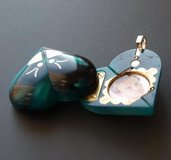
|
|||
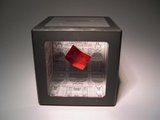
A bank containing a suspended cube. Where does the money go? |
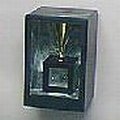
A bank within a bank. |
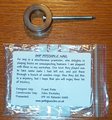
An impossible nail in a donut. |
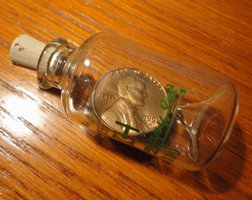
An impossible Penny in a Bottle |
||

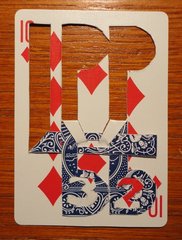
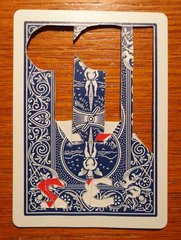
Card-Folding Wizardry by Louis Coolen - a gift from Allard Walker. Thanks! It was great meeting Allard and several other puzzlers at IPP32 for the first time in person. I wish I had had more time to socialize. |
||
|
1851 Great Exhibition London, England 
|
The "Great Exhibition of the Works of Industry of All Nations"
(or just
"The Great Exhibition"
for short)
was based on an idea of Prince Albert's, was held in 1851 in the Crystal Palace in Hyde Park, London, and
was the first international exhibition of manufactured products.
The Crystal Palace is the icon of this fair.
I believe this vintage jigsaw puzzle is a souvenir.
It is 6" x 6" x 1/4" thick, and the lid is marked:
"The New Puzzle. Registered Industrial Exhibition - Registered According to Act of Parliament"
There is a label inside the lid, probably from a store:
"Rich d. S. Williams - No. 9 Back of Park Street - Bristol"

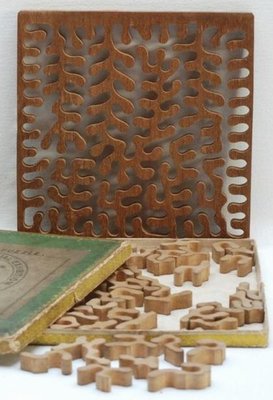
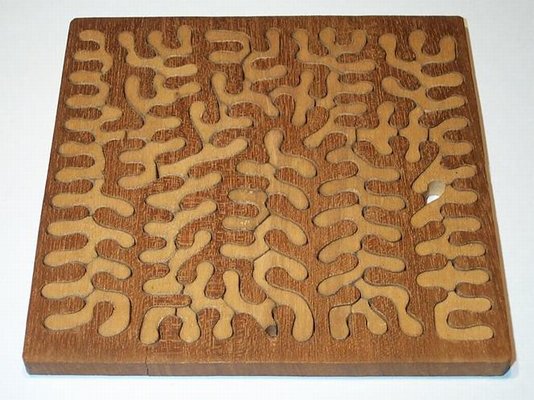
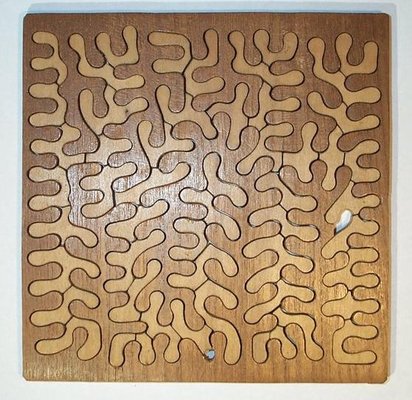
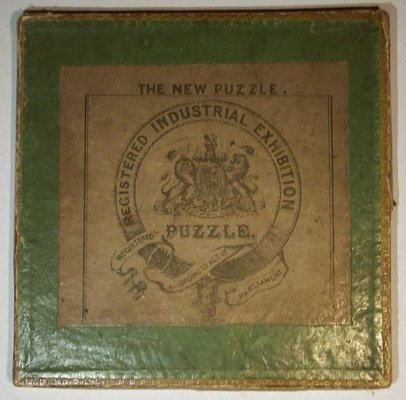
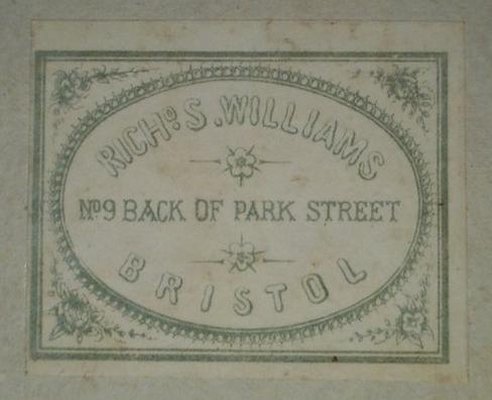
|
||||||||||||||||||||||||
|
1876 Centennial Exposition Philadelphia, PA (Take a tour!) Or, read a book about the expo. |
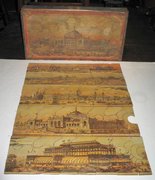 A set of jigsaws (I don't have this). |
||||||||||||||||||||||||
|
1889 Exposition Universelle Paris, France 
|
This fair featured the Eiffel Tower, but I haven't run across any puzzles. | ||||||||||||||||||||||||
|
1893 The World's Columbian Exposition Chicago, IL 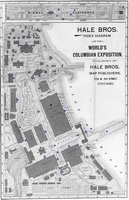
|
The 1893 Columbian Exposition, by all accounts, was a fantastic event.
The buildings were clad in white plaster and the grounds were known as the "White City."
Peter Nepstad has created a
text adventure game
that puts you at the Fair.
Read
some
reviews.
Download a demo.
Also see
The Devil in the White City
by Erik Larson.
|
||||||||||||||||||||||||
|
1901 Pan-American Exposition Buffalo, NY |
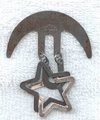
The Stars and Crescent puzzle was stamped to commemorate the 1901 Pan American Expo in Buffalo NY. I have this puzzle, but it's not stamped. |
||||||||||||||||||||||||
|
1904 The Louisiana Purchase Exposition St. Louis, Missouri |
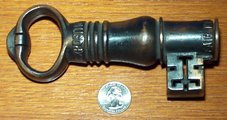
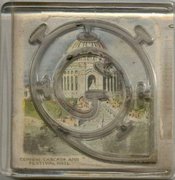


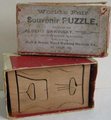
I have the Key, the Up-To-You, and the sliding piece puzzle. I don't have the Jug or the furniture jigsaw.  Robert Hendershott (b.1898 d.2005) actually attended the 1904 fair and compiled a seminal catalog listing scads of memorabilia from the fair. I borrowed a copy from my library, but sadly it did not mention the Key, nor any other puzzle beyond the Up-To-You glass dexterity puzzle. Here is another interesting puzzle from the Expo - it's a pair of coins with slots in them. I obtained a set including the strap! I found a U.S. patent describing the puzzle and the method of [un]linking them with the strap: 748245 - Willey & Barton 1903 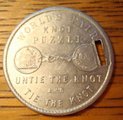
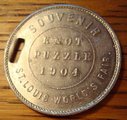
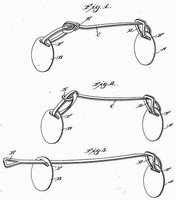
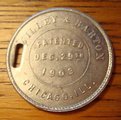
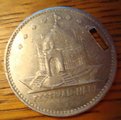
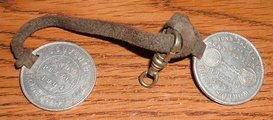
|
||||||||||||||||||||||||
|
1915 Panama-Pacific International Exposition San Francisco, CA 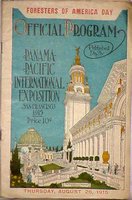
|


|
||||||||||||||||||||||||
|
1933 Century of Progress Chicago, IL 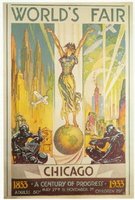
|
There were several puzzles associated with this fair.
|
||||||||||||||||||||||||
|
1939 New York World's Fair NY, NY 
|
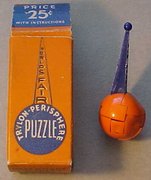
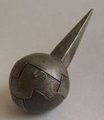 The Trylon Perisphere is the icon for this fair. A small interlocking puzzle of the Trylon Perisphere was issued
and became the forerunner of the keychain puzzle.
There was also a version in metal - I have the plastic version.
The Trylon Perisphere is the icon for this fair. A small interlocking puzzle of the Trylon Perisphere was issued
and became the forerunner of the keychain puzzle.
There was also a version in metal - I have the plastic version.
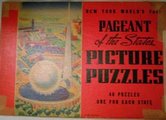
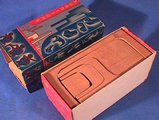
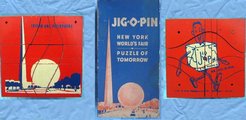
I have the Pageant of the States puzzle; I don't have the Furniture Jigsaw or Jig-O-Pin. |
||||||||||||||||||||||||
|
1962 Century 21 Exposition Seattle, WA 
|
 I don't have this. |
||||||||||||||||||||||||
|
1964,65 New York World's Fair NY, NY (NOTE: Not sanctioned by the BIE.) 
|
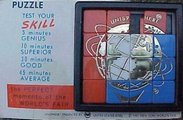
I don't have this. |
||||||||||||||||||||||||
|
1967 Expo '67 Montreal, Canada 
|
|||||||||||||||||||||||||
R O T A S O P E R A T E N E T A R E P O S A T O R |

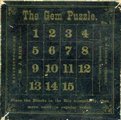
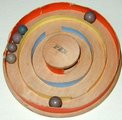
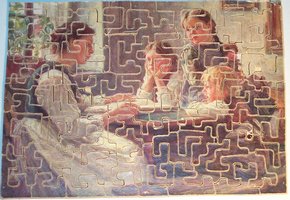
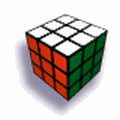
|
Since 2001, the IPP has held a design competition, now known as the Nob Yoshigahara Puzzle Design Competition. You can see the entries and results at John Rausch's site.
Throughout my website, you'll find many other puzzles that have appeared in the Design Competition in recent years - below, I've gone through the entry lists and noted the puzzles I've acquired:
2001
|
2002
|
2003
|
2004
|
2005
|
2006
|
2007
|
2008
|
2009
|
2010
|
2011
|
2012
|
2013
|
2014
|
2015
|
2016
|
2017
|
2018
|
2019
|
| Several manufacturers around the world, from the late 1700's onwards to the present day, have issued collections of puzzles in boxed sets. | |
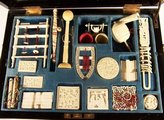
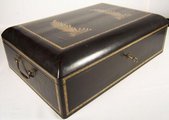 Perhaps the most sought-after are collections of puzzles made from ivory, arranged inside lacquered boxes, exported
from China in the 1800's.
One such set is shown here - sadly I do not own it - it sold for over $4000!
The Hordern-Dalgety Puzzle Museum site has an article on
Chinese Puzzle Sets.
There is also an article on the British firm
John Jacques & Son, who made boxed sets of
puzzles,
indoor and outdoor games, and other items.
Jacques of London
was founded in 1795 and is still around today!
Perhaps the most sought-after are collections of puzzles made from ivory, arranged inside lacquered boxes, exported
from China in the 1800's.
One such set is shown here - sadly I do not own it - it sold for over $4000!
The Hordern-Dalgety Puzzle Museum site has an article on
Chinese Puzzle Sets.
There is also an article on the British firm
John Jacques & Son, who made boxed sets of
puzzles,
indoor and outdoor games, and other items.
Jacques of London
was founded in 1795 and is still around today!
|
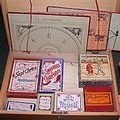
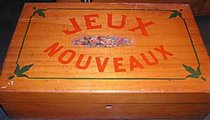 Other boxed sets of puzzles have come from French manufacturers, such as the "Jeux Nouveaux" set shown above
(I do not own).
Other boxed sets of puzzles have come from French manufacturers, such as the "Jeux Nouveaux" set shown above
(I do not own).
See more about vintage French puzzles and sets at the website of the avid French collector Alain Koli. In the U.S. the venerable toy store F.A.O. Schwartz issued boxed puzzle sets (I have one shown below). |
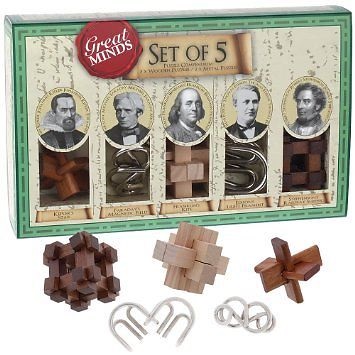
Great Minds Set of 5 Puzzle Compendium A gift from Claire and Steve - thanks! |
||||||
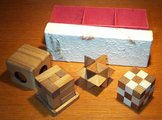 This boxed set contains a Soma cube, a Star, and a Cube Snake. |
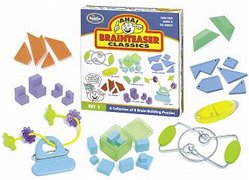 The "Aha Brainteaser Classics" set from Thinkfun contains a nice introductory survey of simple mechanical puzzles, with hint cards. Here is a nice history of some of the puzzles included in this set. |
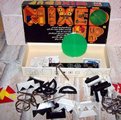 This compendium is called "Mixed Up." |
||||
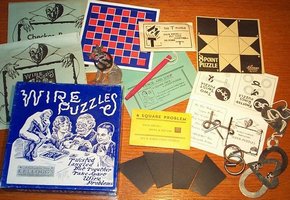 This compendium was made by Sherms of Bridgeport CT (the included instruction sheet clearly indicates so, as do the several appearances of the leering devil), but branded on the box lid by Kellogg's of Springfield MA (probably a department store). Although the lid says "Wire Puzzles," the set contains the Perigal 4-piece square, the classic T dissection, Loyd's buttonhole pencil, the 8-point puzzle, a sitting Doggie puzzle, several metal tanglements, and a 14-piece checkerboard dissection called the "Checker Board Problem" made from thick cardboard in blue and red (Haubrich 14.14.3-5, pieces on page 165, listing on page 168 #11). The instruction sheet says "This book of puzzles explains others besides those in your set." It's not at all clear whether the current contents are the original contents. The instructions sheet lists:
|
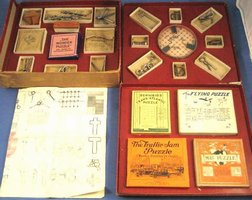 This is the "Party Puzzle Box Supreme," a compendium of several puzzles, from George E. Schweig & Son of Philadelphia PA. The box is in poor shape, but it contains several interesting puzzles. The box contains three trays / levels. The first tray contains four sliding block puzzles in good shape: Schweig's Trans-Atlantic Puzzle, The Flying Puzzle, The Traffic Jam Puzzle, and Ma's Puzzle. (I bought this to obtain the Trans-Atlantic puzzle.) The next tray contains eight hard wire tangles, some of which are incomplete, and a dexterity puzzle called "Who Catches Us?" The last layer contains the classic T dissection (missing one small part), "The Wonder Puzzle" (a tangram variant, missing a block or two and a booklet), a "Spoophem" type puzzle, six more tangles including Patience, and a six-piece burr, the same "Puzzle of Puzzles" as in the "Tricks and Puzzles" compendium. There is also an instruction sheet. |
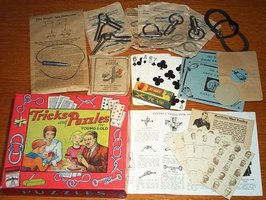 This set is called "Tricks and Puzzles for Young and Old" and I cannot find additional provenance info even on the instruction sheet. One of the included tricks, however, called "Mystifying Mind Reading," is labeled No. 1 N 136 Copyright 1928 N. S. Co. Chicago. Also, many of the individual item packages say "Made in Japan." The set includes: the aforementioned Mystifying Mind Reading trick, which contains six cards having pictures of 15 presidents; a traditional six-piece burr puzzle called "The Puzzle of Puzzles" made in Japan (pieces 1, 154, 256x2, 1024x2), four copies of the ring and clip hard wire tangle, two copies of a hard wire tangle similar to offset keys, plate metal horseshoes, two copies of "No. X 2234 Coin or Disc Thru Hole," "The Magic Sex Indicator" (a plumb bob), an "X-Ray" tube, a card trick (incomplete), and a sheet of instructions. The instructions describe:
|
||||
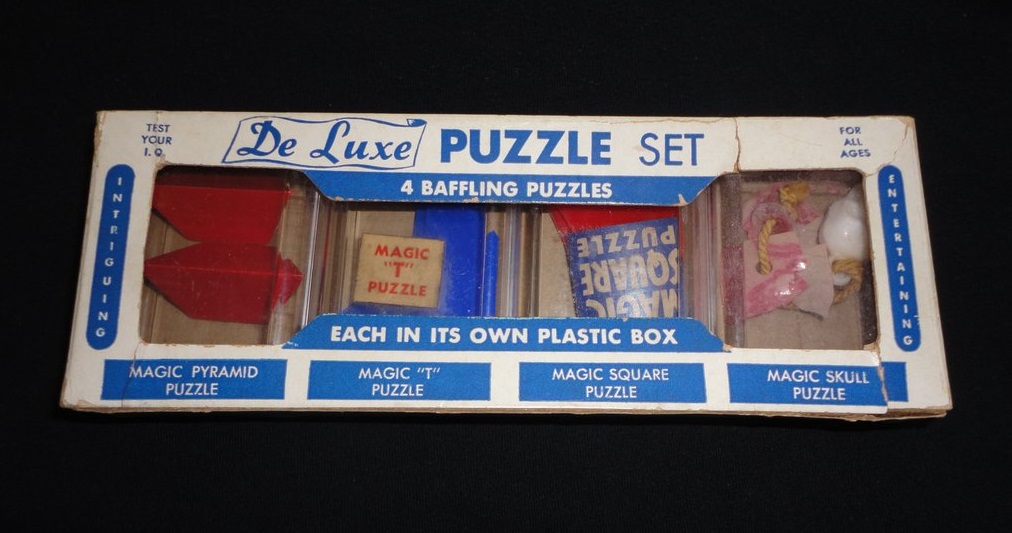
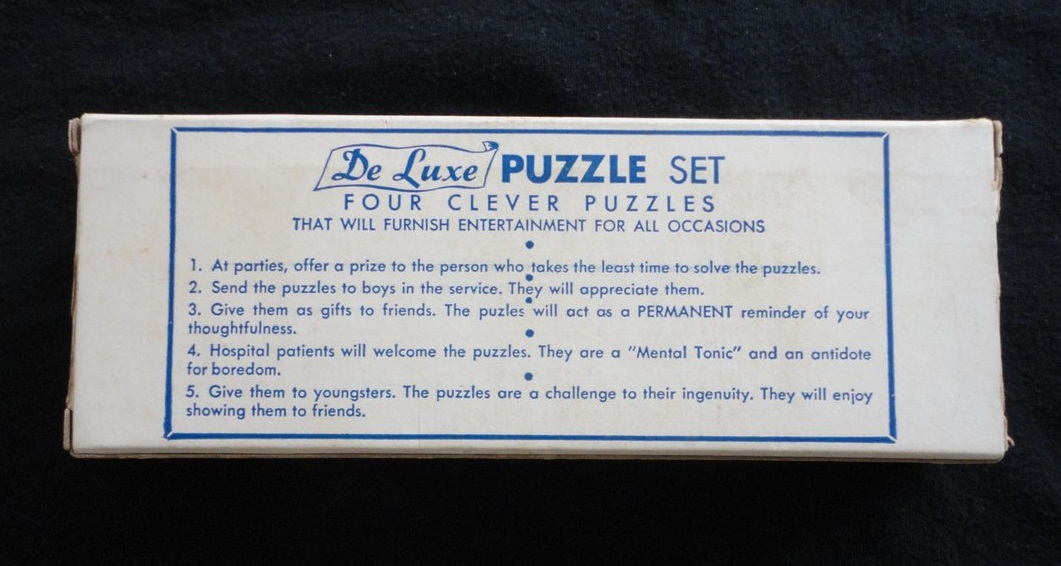
De Luxe Puzzle Set - issued by D. Robbins & Co. N.Y.C Copyrighted 1953 A nice set of four classic brainteasers. I picked up spares because the first 3 of these are popular items in my "puzzle go bag." |
||||||
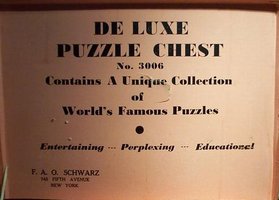
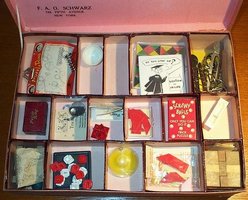
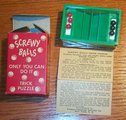 Screwy Balls Get 3 black balls on one end and 3 red on the other. A secret trick is involved. |
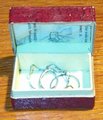 Puzzle Ring |
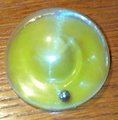 a version of "Upsy Downsy" - get the ball up the ramp to the pinnacle |
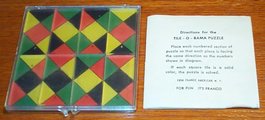 Tile-O-Rama |
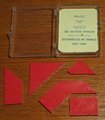 Magic H |